Rickubis Bird
Page #11: Spoonbills
This page was born
03/22/2022-from material already posted. Rickubis designed
it. (such as it is.) Last update: 01/13/2025
Images and contents on this
page copyright ©2002-2025 Richard M. Dashnau
Go back to my
home page, Welcome to
rickubis.com
Go
back to the RICKUBISCAM
page.
----------------------------------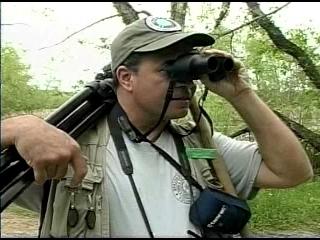
Welcome to Brazos Bend State
Park. That's me on the trail. One of the most popular reasons for
people to visit BBSP is to see the birds. Although *I* started
going to the park
mainly for the alligators, one cannot be there for long without
learning to enjoy the birds. Over the years, I've captured a few
pictures and video clips of them, and here they are.
12/21/2024
Sometimes, when I go to Archbishop
Fiorenza Park, I get lucky. This time, a pair of Roseate Spoonbills
(Platalea ajaja) were foraging not too far from the low bridge.
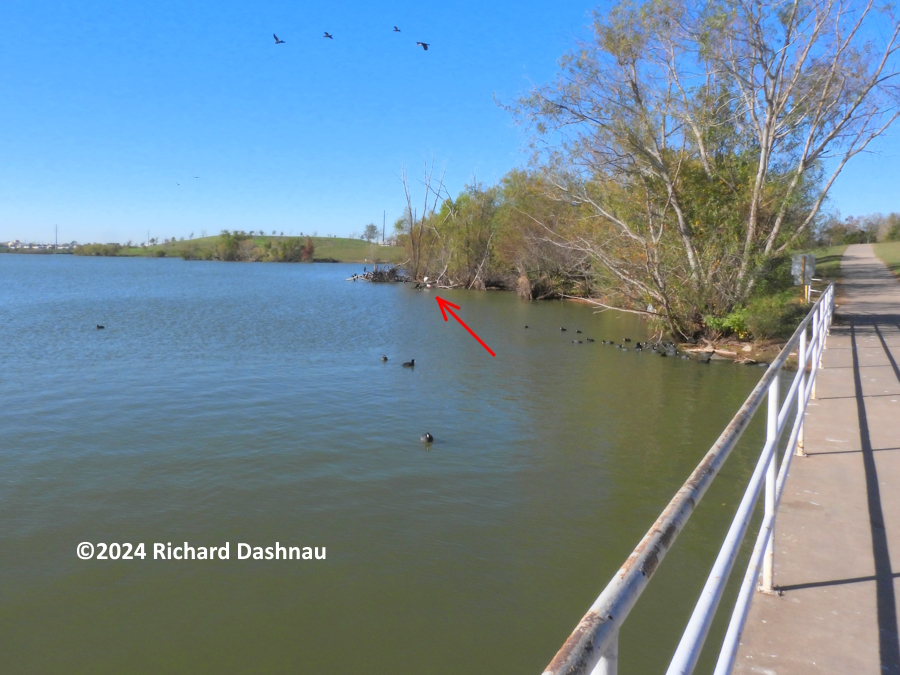
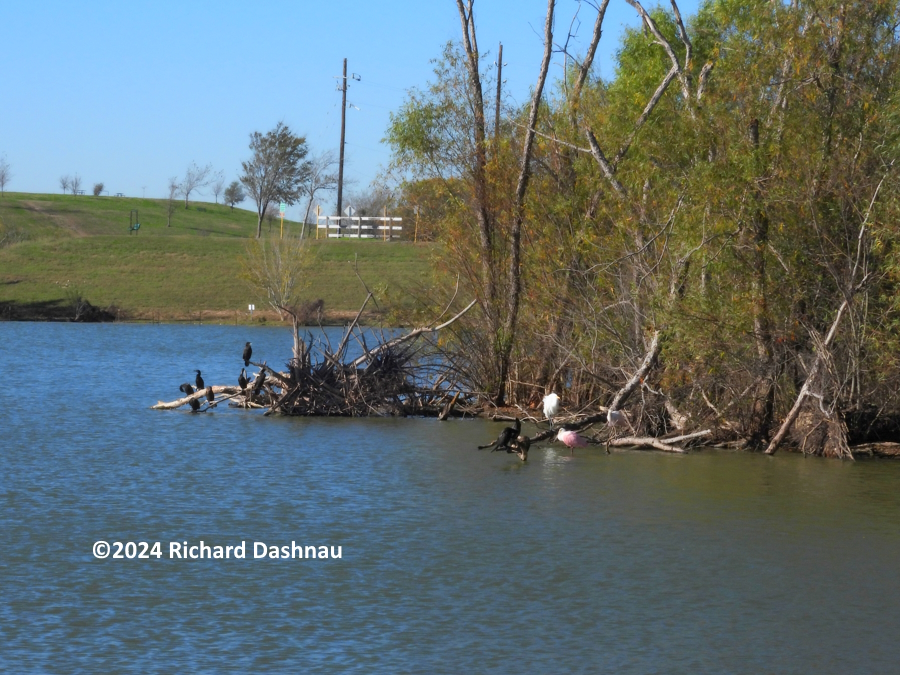
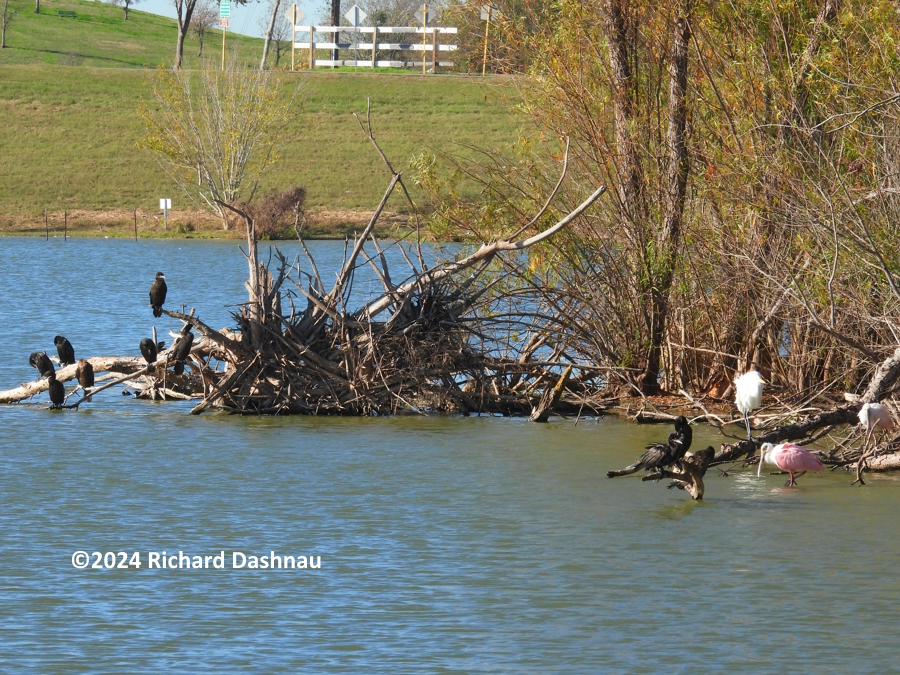
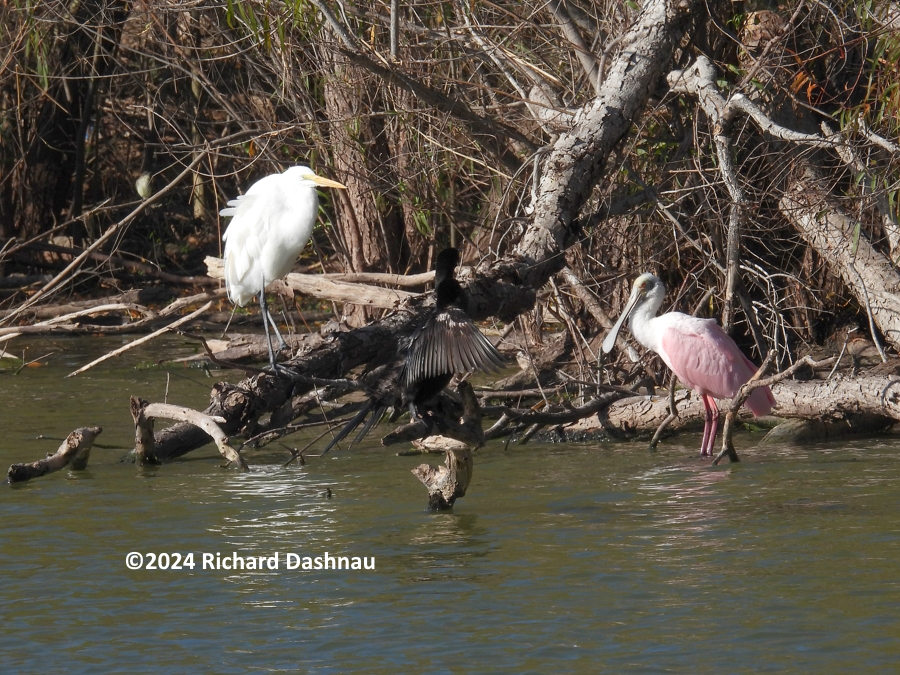
They
foraged near a
spot that was
also popular
for resting
among the
branches. Some
Neotropic
Cormorants (Nannopterum
brasilianum)
and a Great
Egret (Ardea
alba)
rested there.
I captured
some video, shown
here.
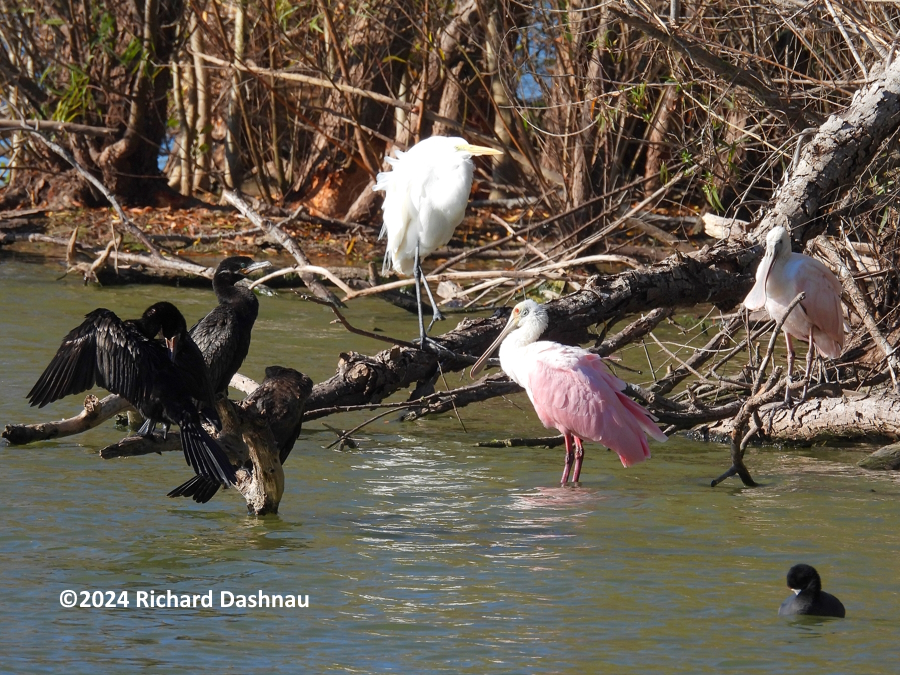
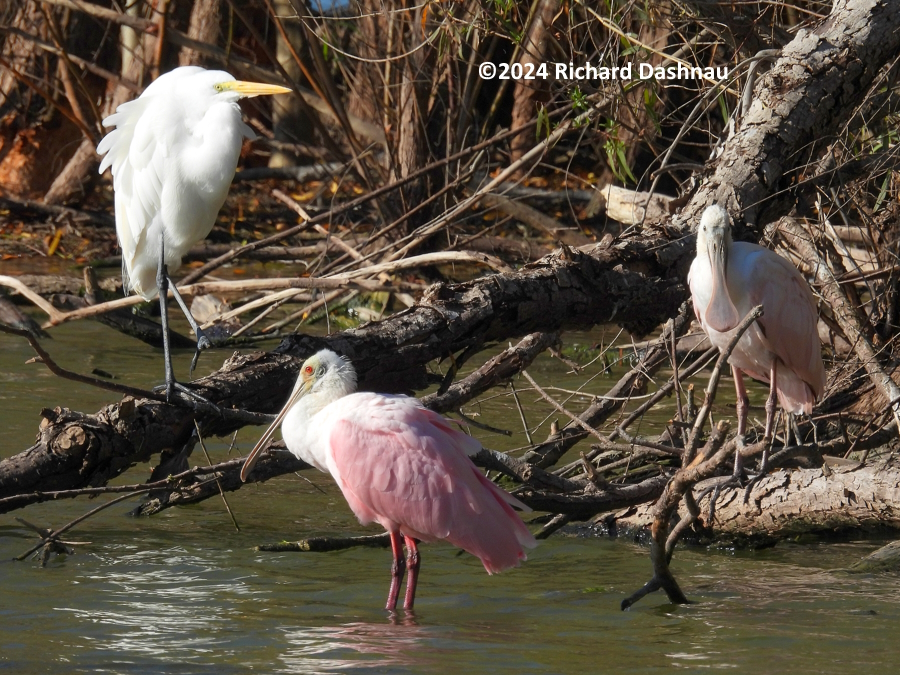
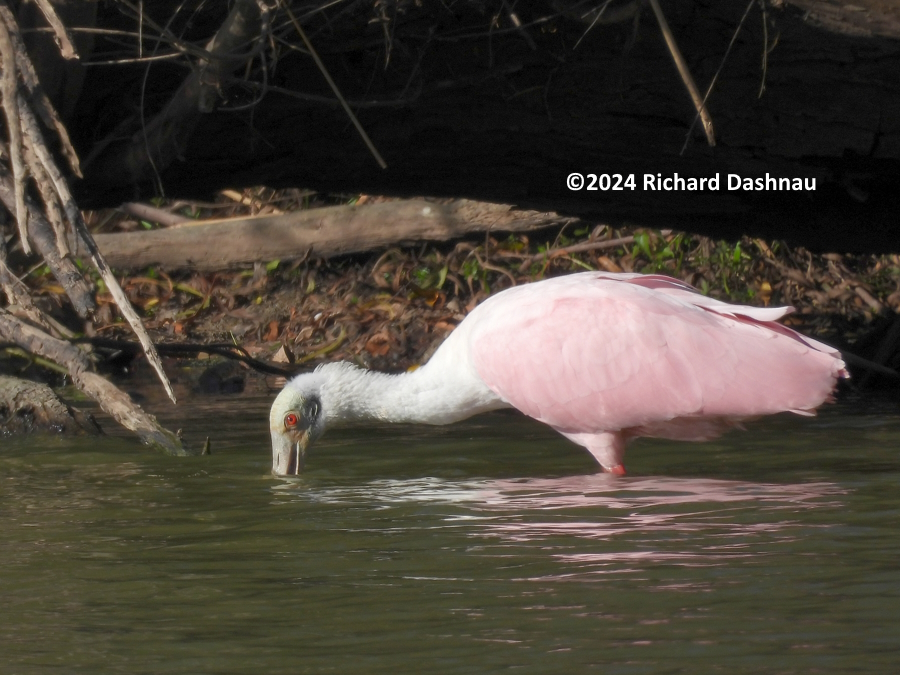
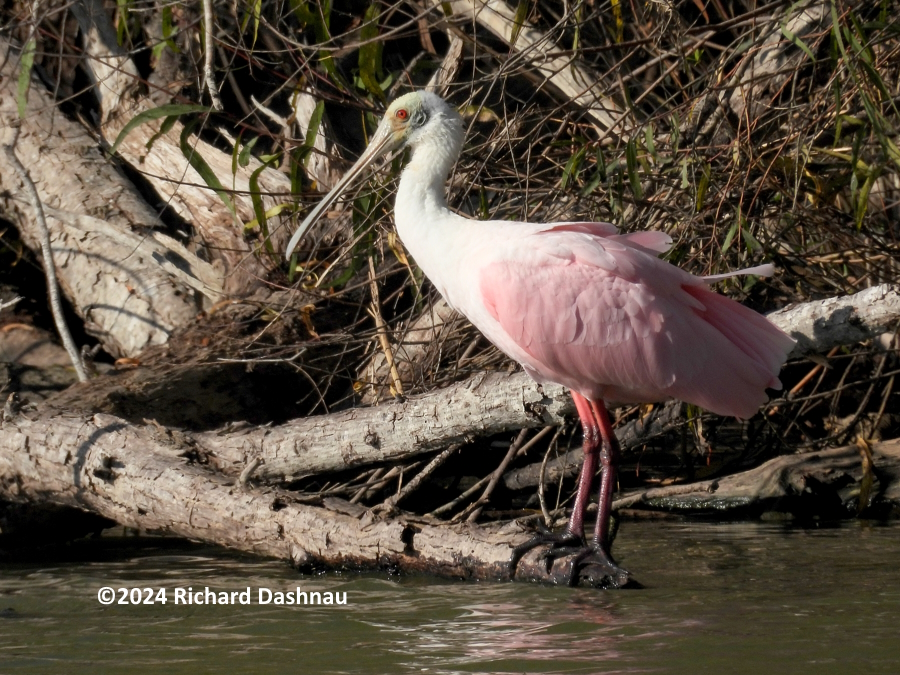
One
of the
Spoonbills was
more colorful
than the
other. It's
possible that
this was a
mated pair,
and the more
colorful on
was a male.
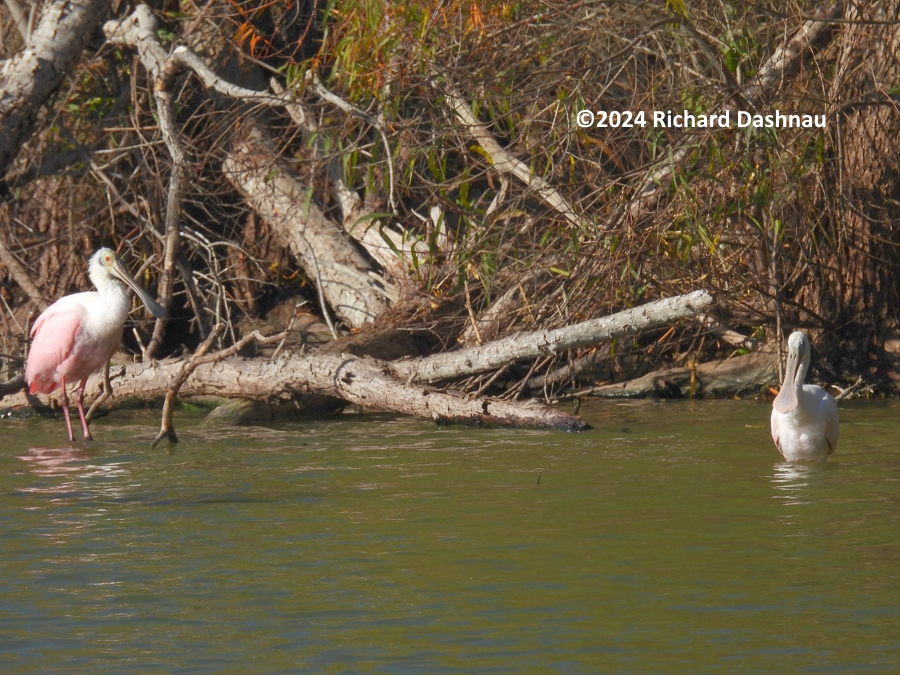

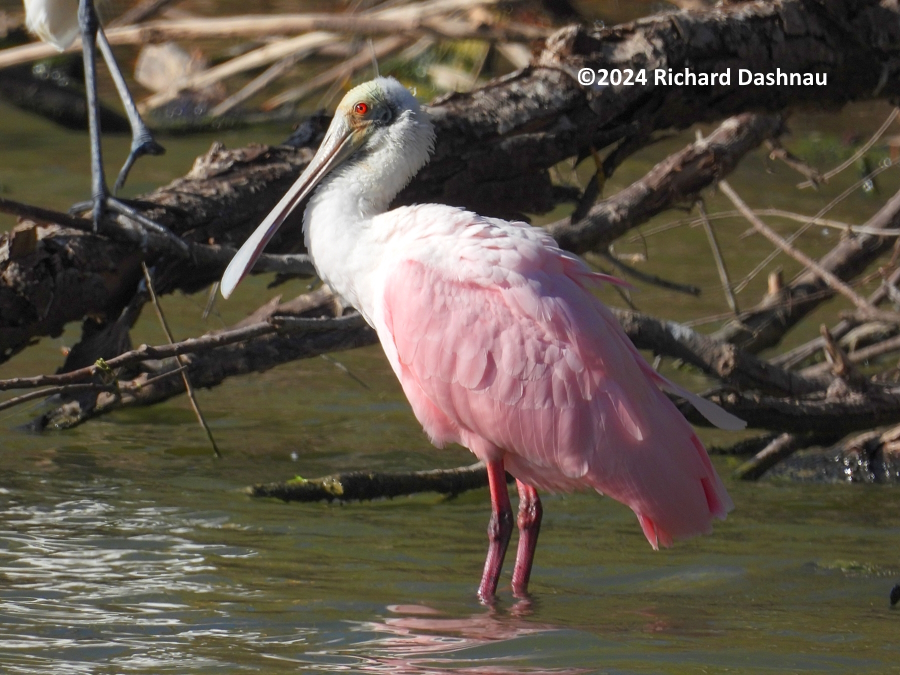
11/03/2024
At
BBSP, while
walking on the
Spillway
Bridge around
8:30am; I'd
been hearing
Limpkins
calling to the
South. But
they were far
away, and
out of sight.
I'd stopped on
the bridge to
just look
around. The
view to the
South now
shows parts of
the "mile
stretch"
section of the
road--which
hadn't been
visible until
recently.
A Roseate
Spoonbill flew
over me, and
landed a few
hundred yards
Southwest, so
I decided to
experiment
with some
photos. All of
these are
cropped from
the originals,
but
the last one
wasn't too
bad.

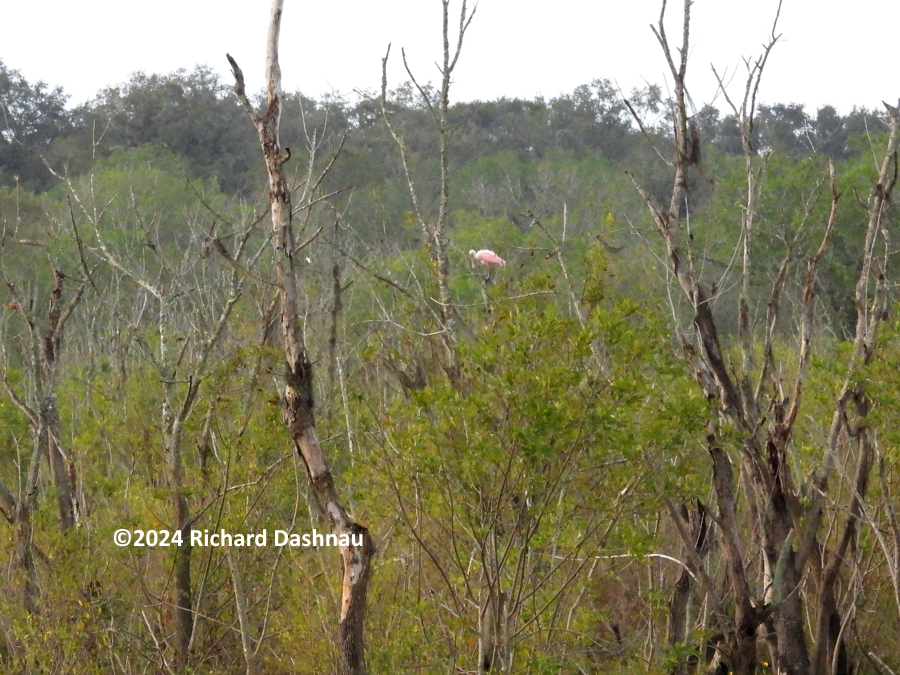
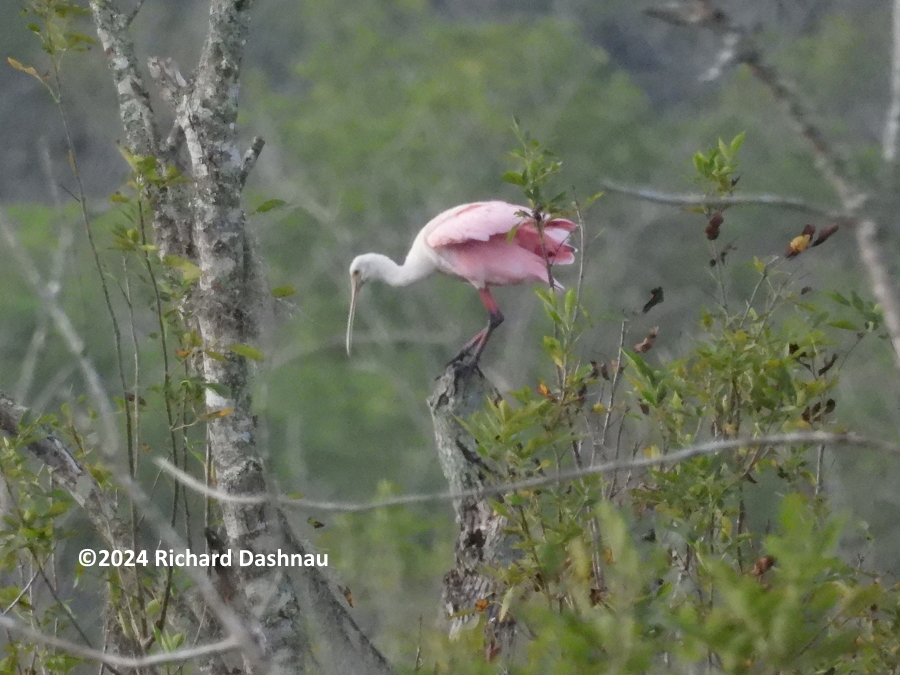
On 03/05/2023 Spoonbills were active around
the islands in 40 Acre Lake through most of the day. I
tried different camera settings and shot a few bursts of
photos, and
I accidentally caught a bit of snarky behavior (or...perhaps
it was flirtatious) between them. I think some of the
pictures turned out quite well! So, here they are.
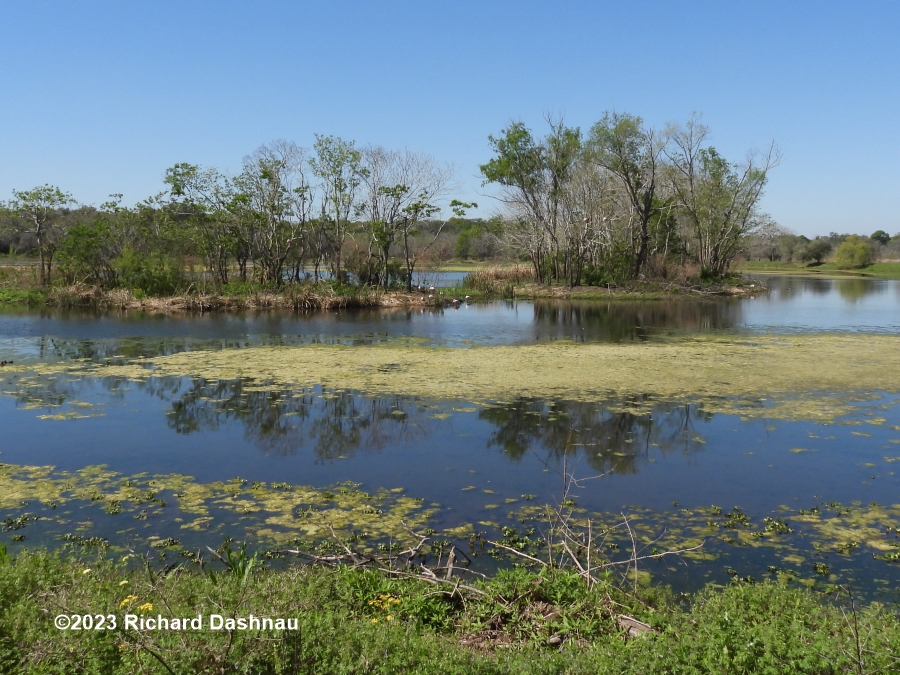
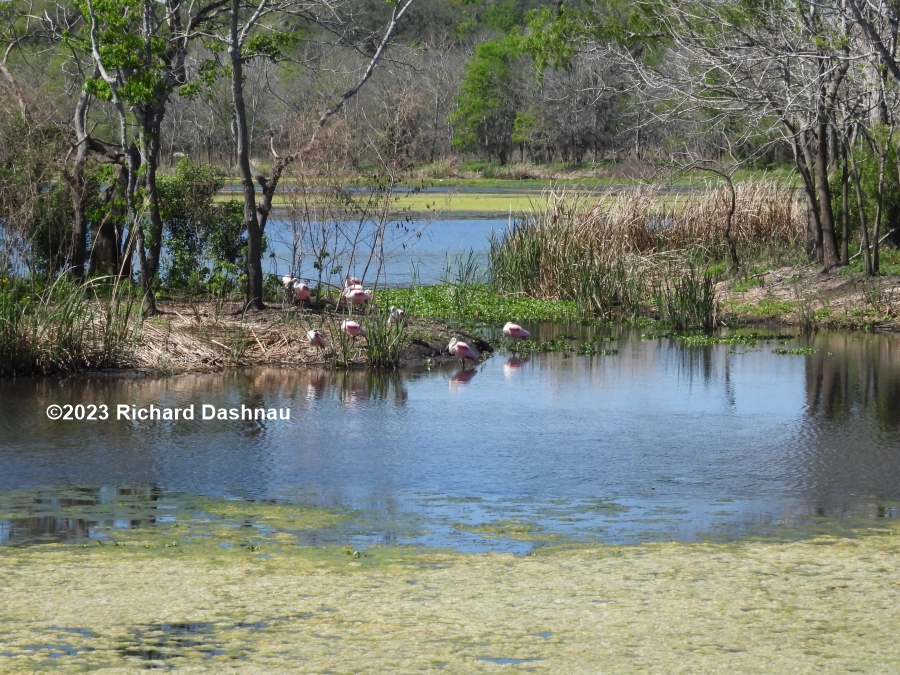
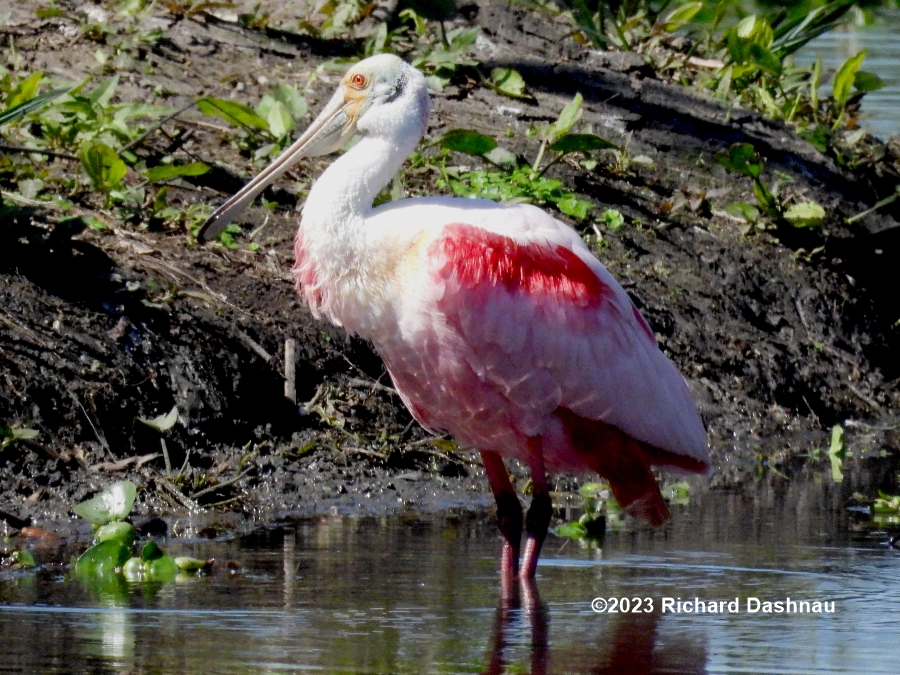
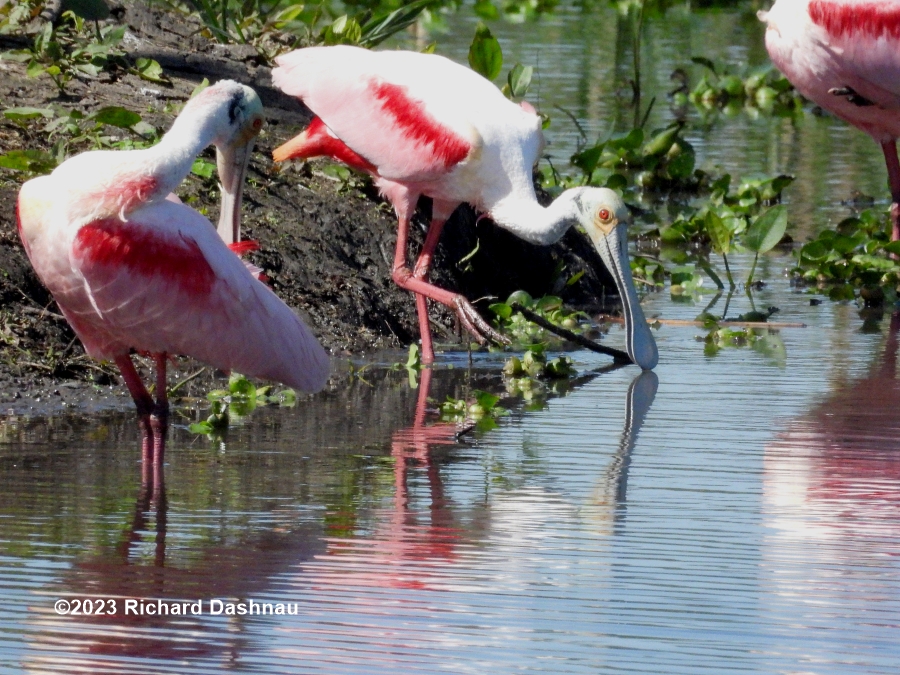
The
images
below show the extreme flexibility of a Spoonbill's neck. In
the first 3 images below, the bird seems to be preening or
grooming by arching its neck backwards and rubbing
the back of its head and neck on its back.
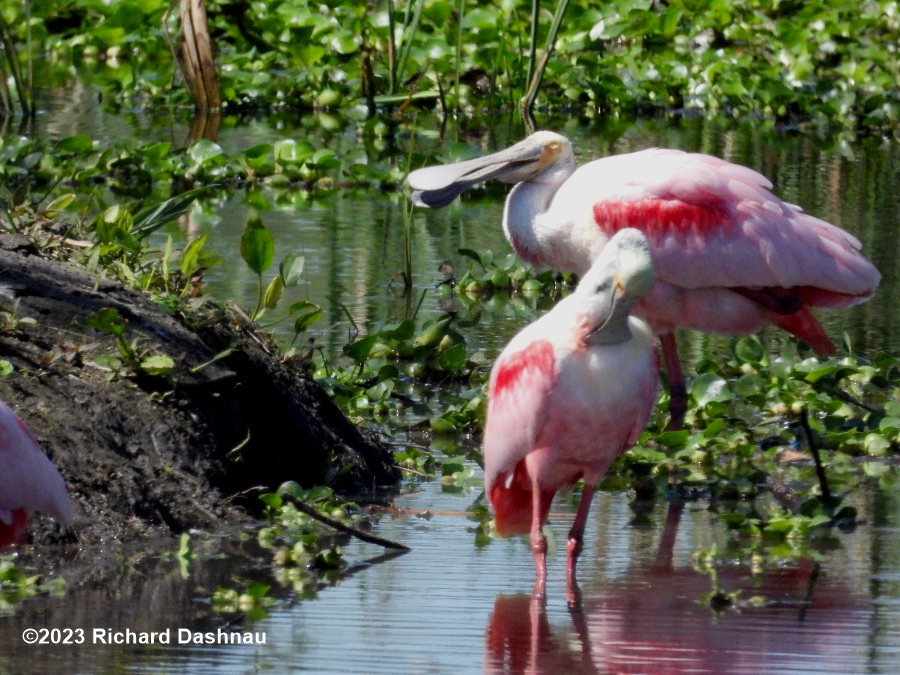
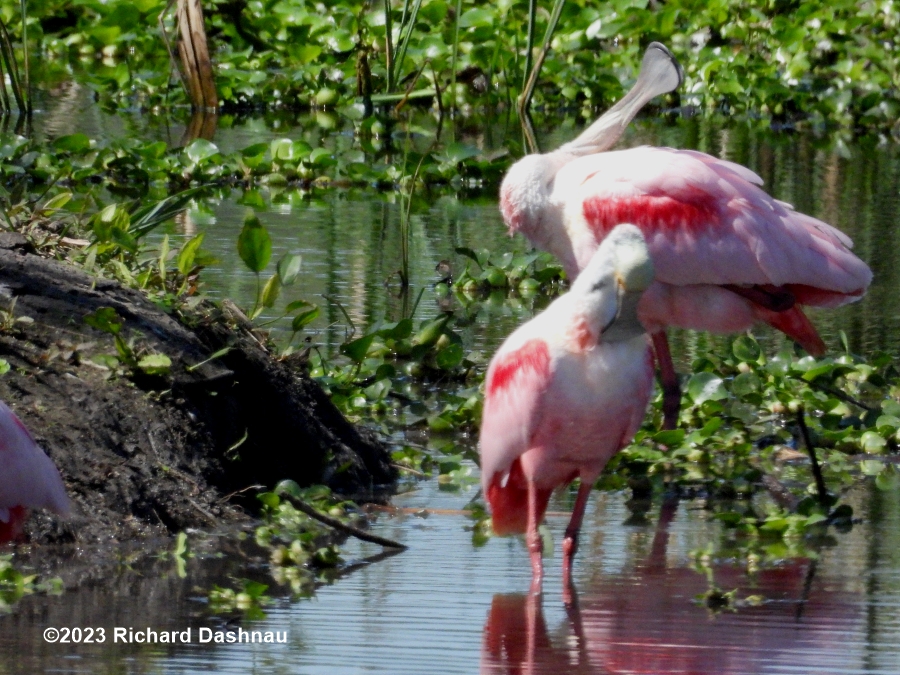
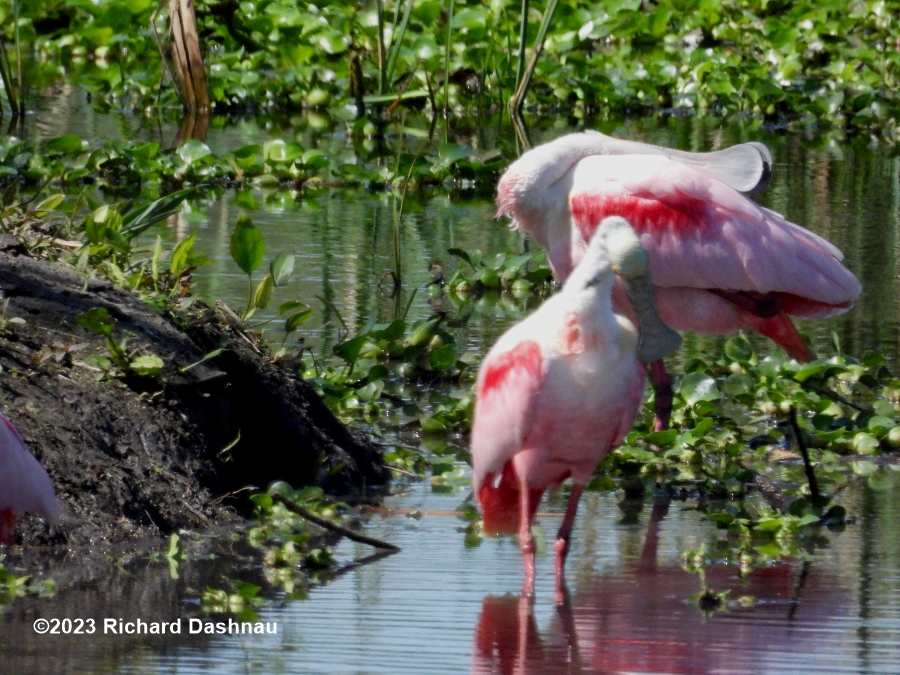
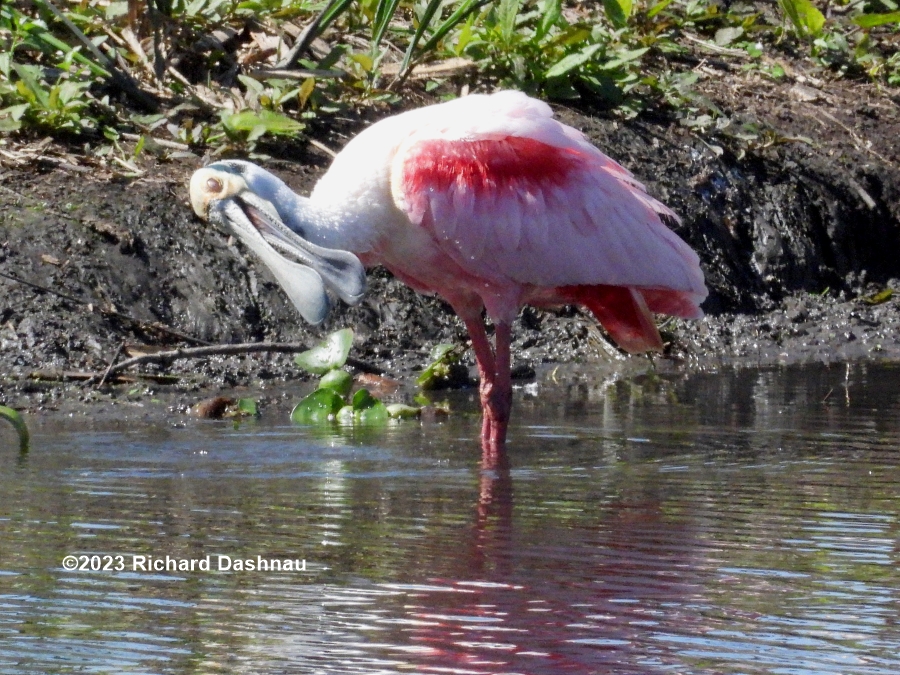
In
the
4th image above, and the first 2 photos below, the Spoonbill
was twisting its head rapidly side-to-side. It was possibly
shaking water or detritus off its bill. But, look at that
kink in its neck,
just behind its head!
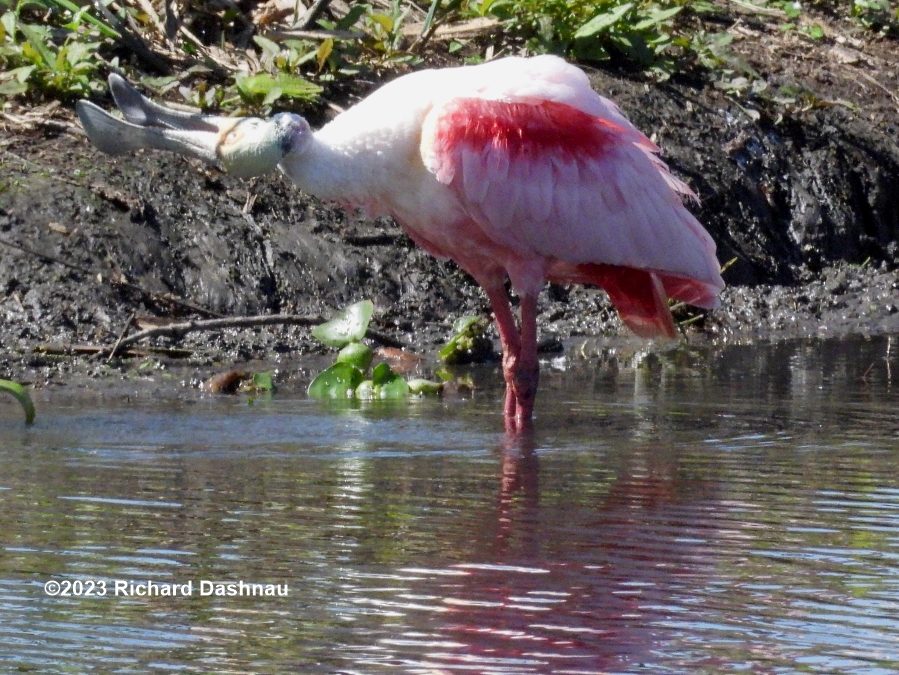
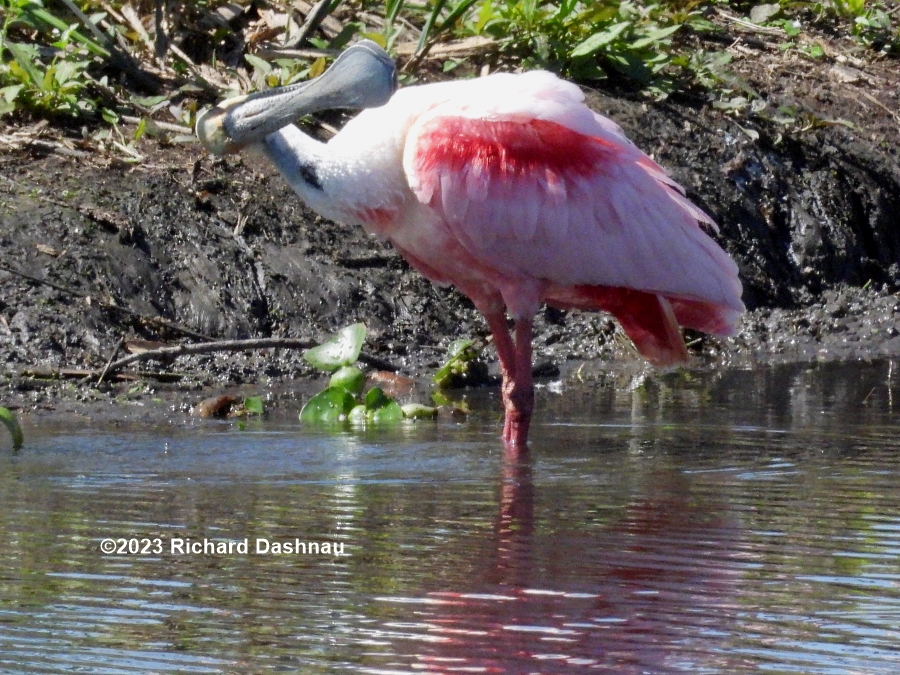
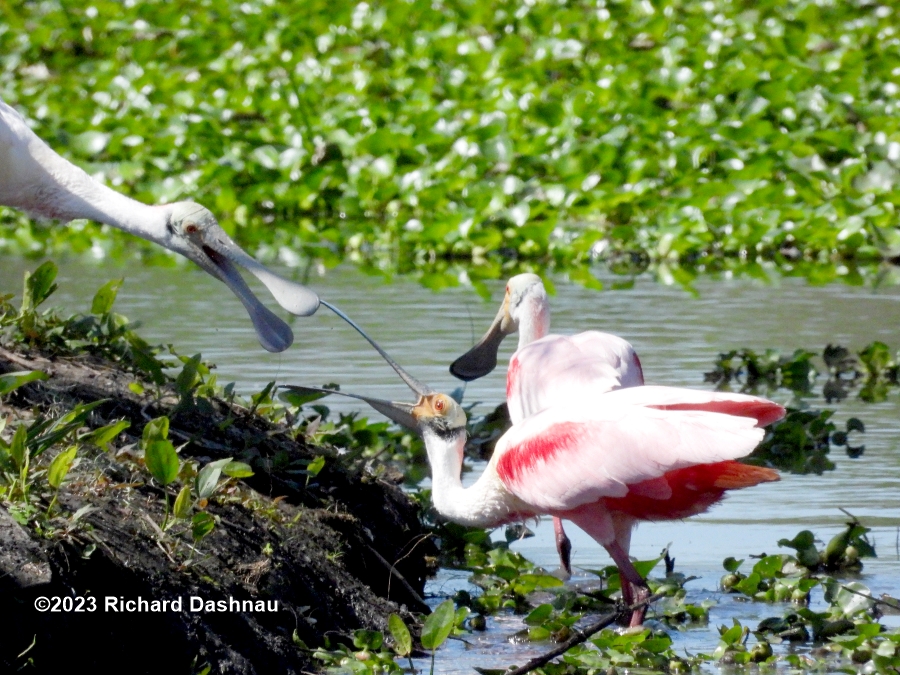
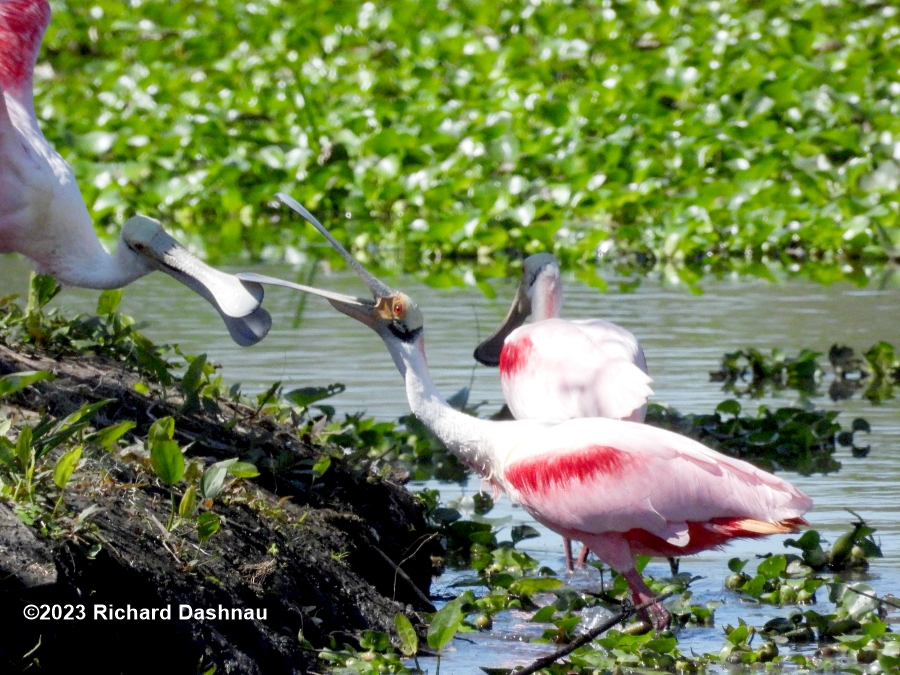
In the 3rd and 4th image
above, the first 4 photos below, and the first 2 below
those, I accidentally caught this brief "clap fight" (or
whatever one calls a contest involving such ridiculous
weapons).
It was over in seconds, before I realized it was happening.
They moved out of frame, but I caught some very nice shots!
I don't know if this was a minor aggression over a
spot on the bank, or
some kind of flirtatious activity as an introduction to
courtship. The birds never tell me what's going on.
The final two images 2 rows down show one wading into the
lake, and I liked the
perspective of the bill.
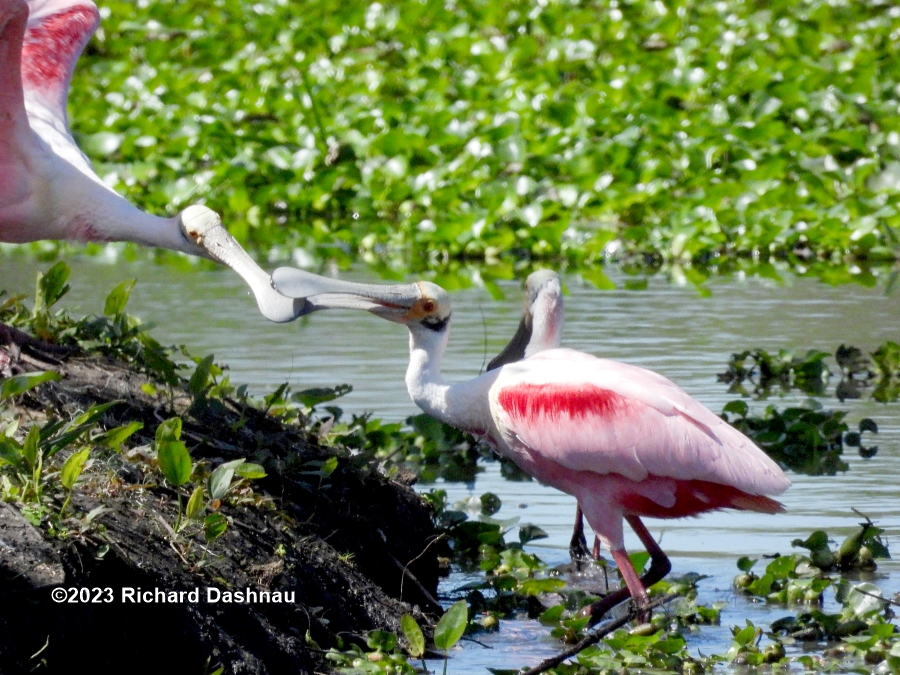
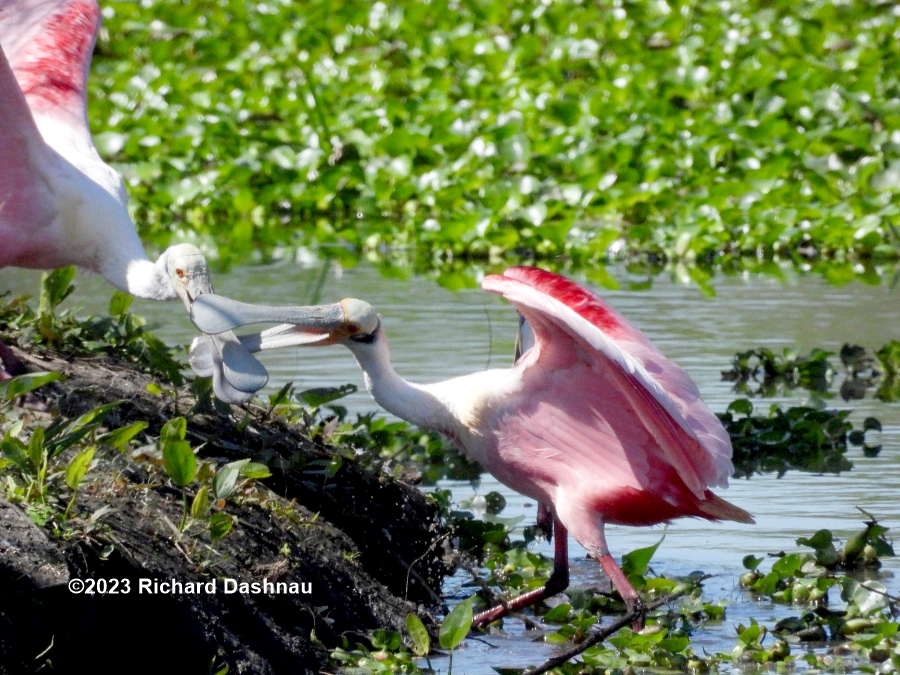
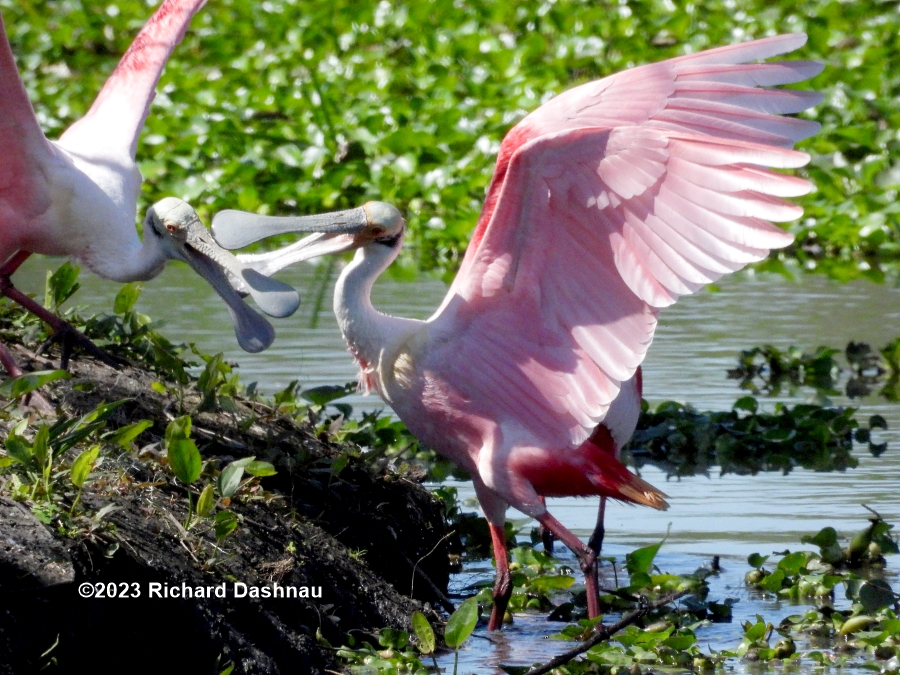
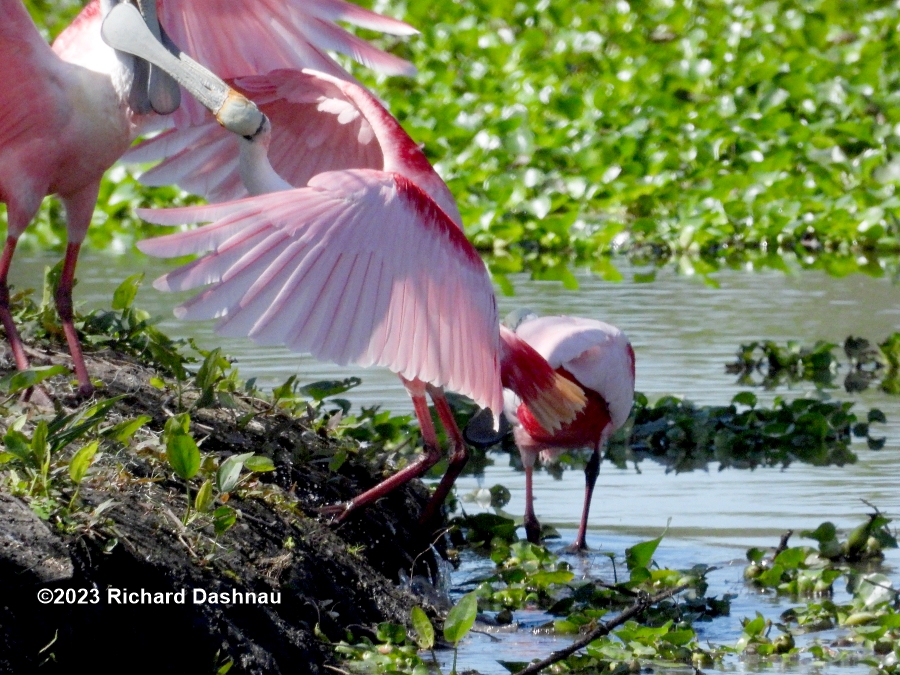
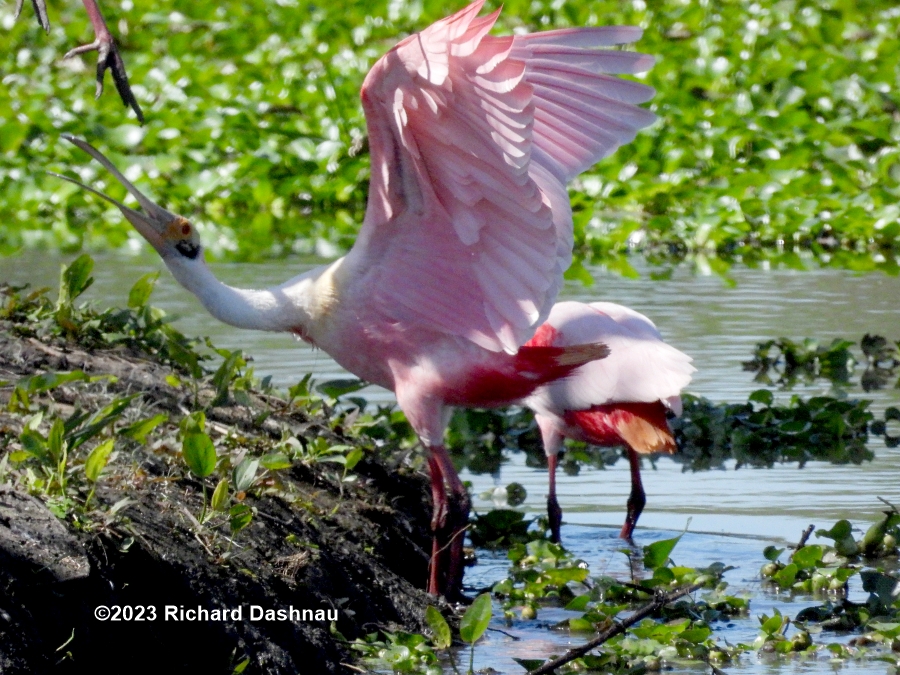
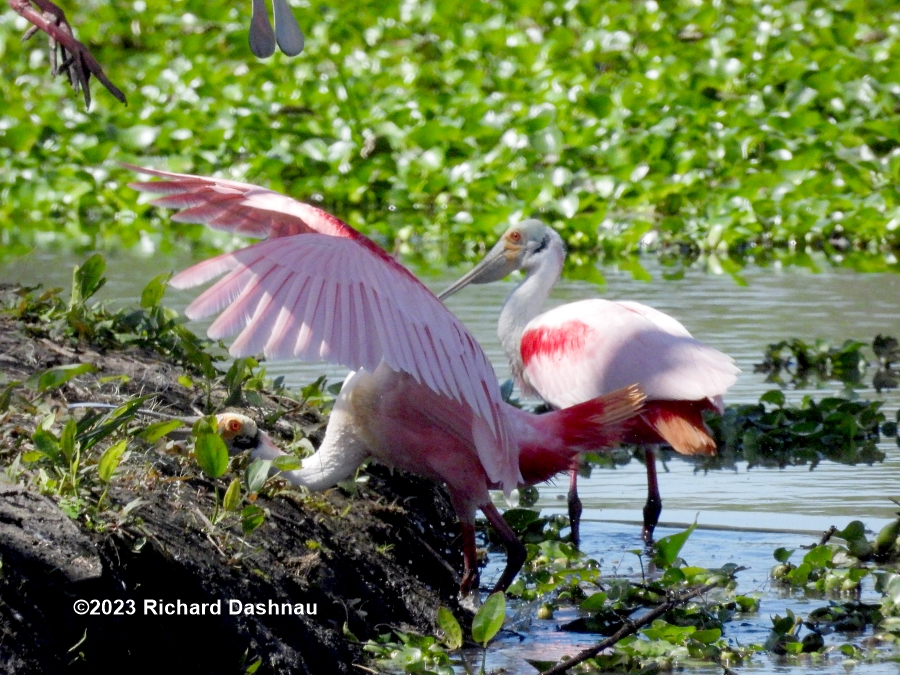
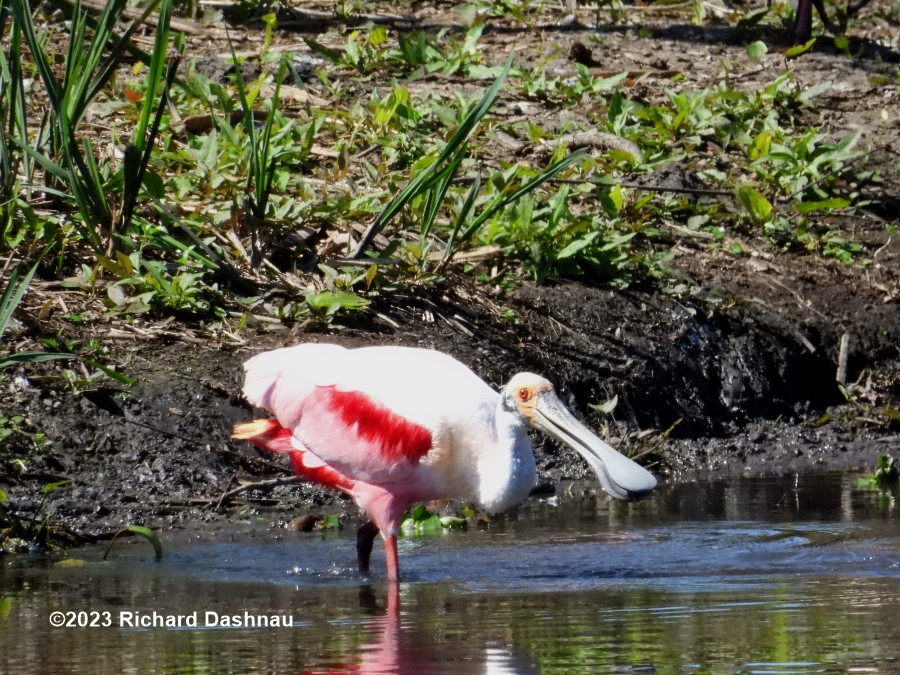
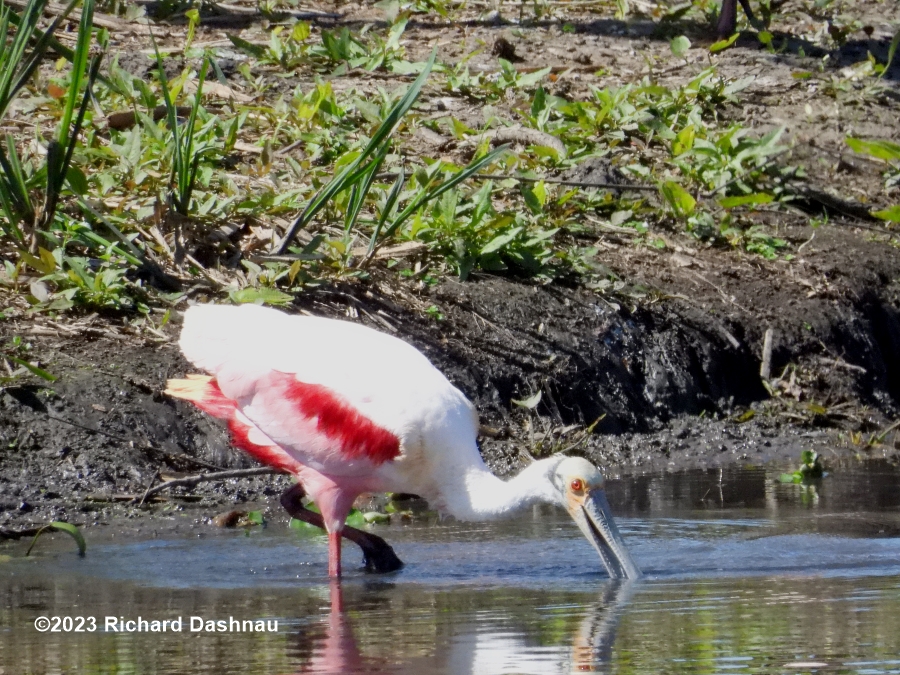
On
02/26/2023 Roseate
Spoonbills
(Platalea ajaja) were working around the islands near the
East corner of the of 40 Acre Lake. The colors of the
Spoonbills stood out
against the overcast grey of the day. The
chewed-up dirt in the foreground was from the Feral Hogs
that had been foraging over the past weeks. I could see the
Spoonbills catching prey near
the islands. They were about 50 yards away and moved
quickly, so even through binoculars I couldn't see what they
were catching. My photos couldn't slow the action, so I shot
video.
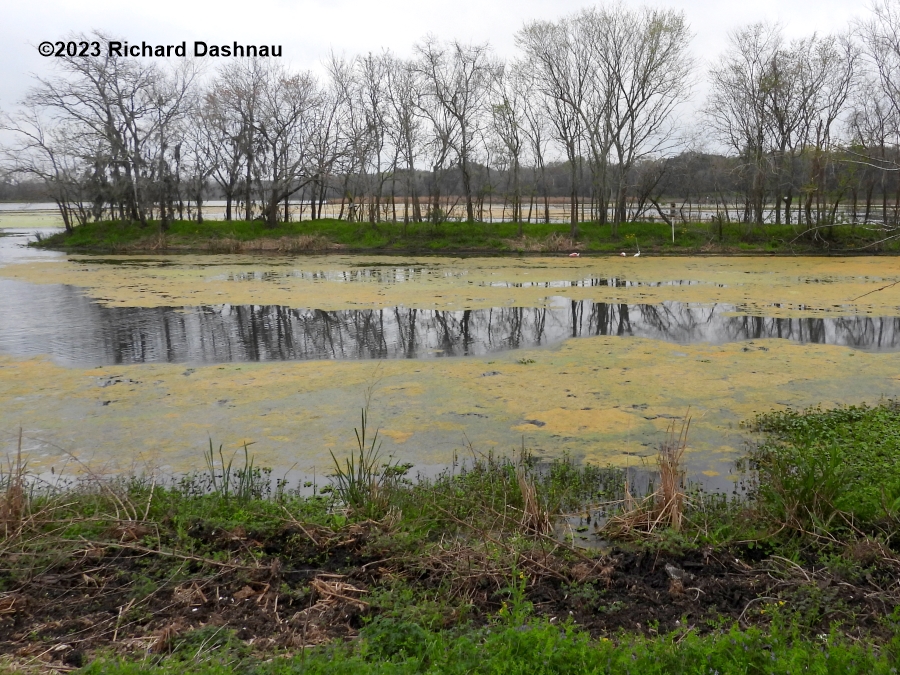
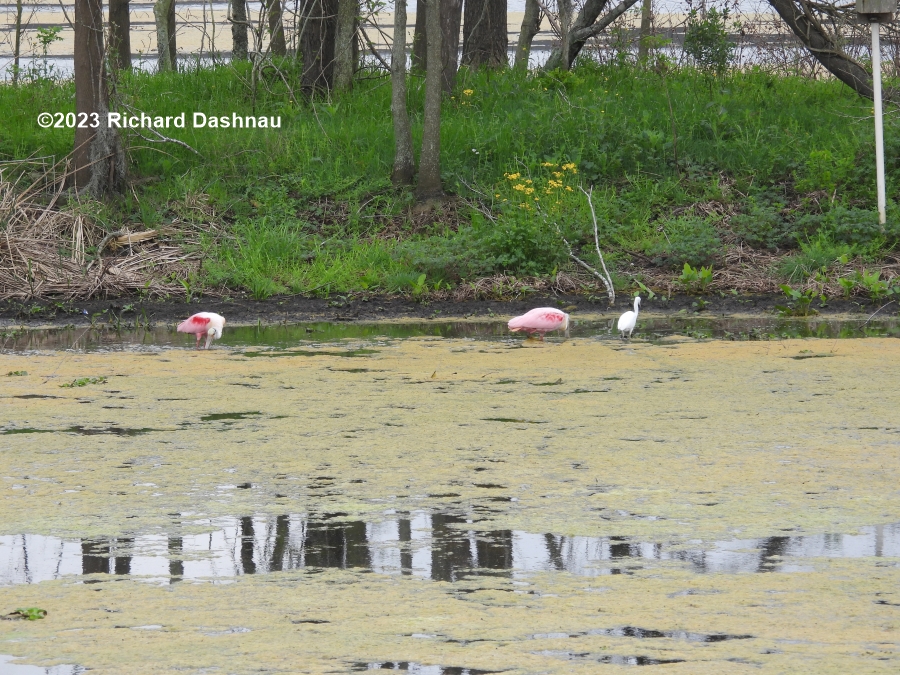
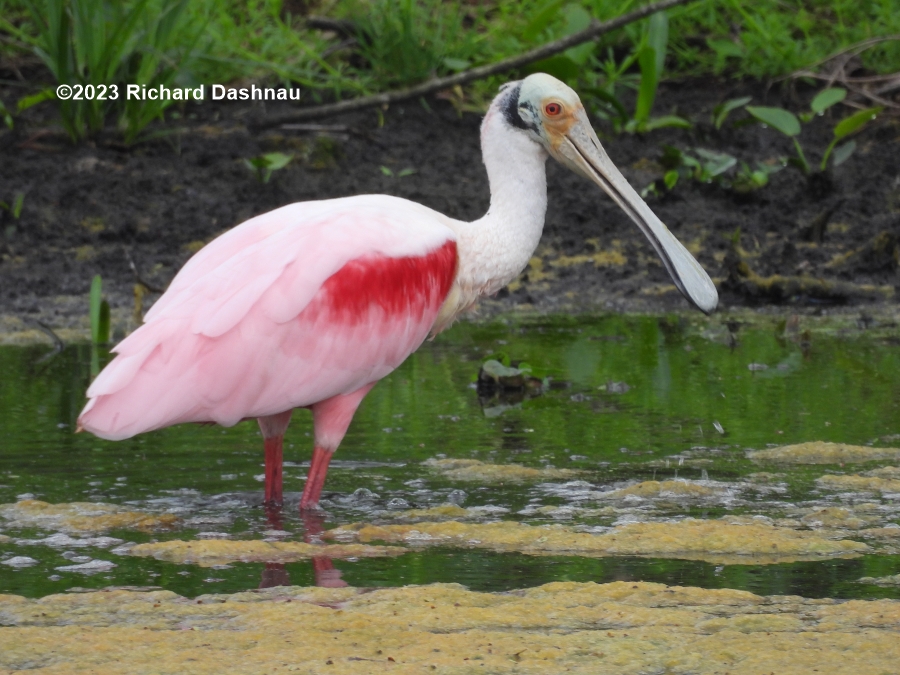
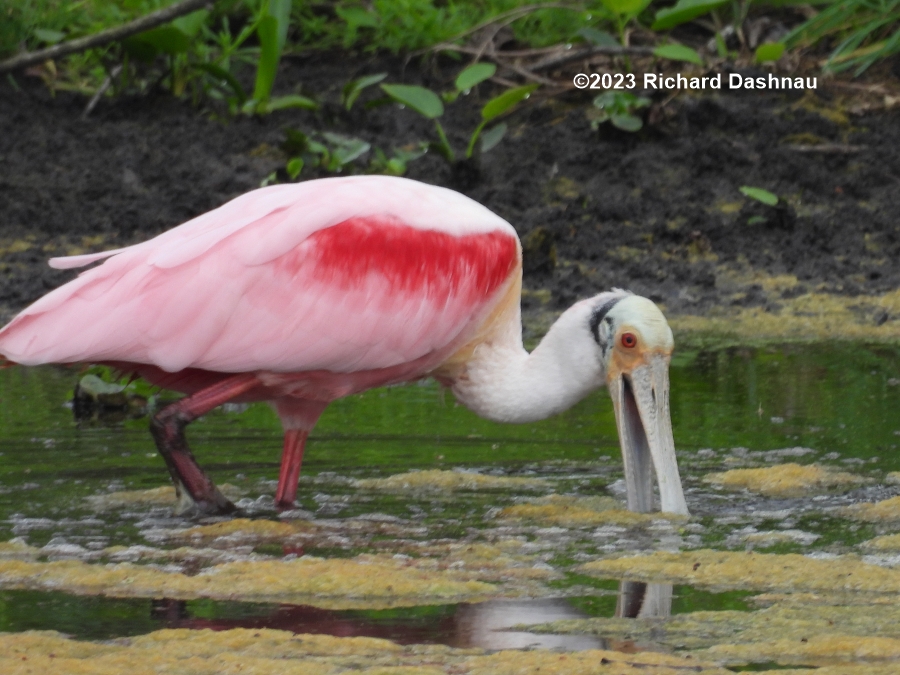
One of them was catching something large. I cropped
and slowed the video to see what it was. I cropped the
video even more, and then slowed it 4 times. Now we
can see that it wasn't
catching multiple items, but only juggling one.
AND...it was a crawfish! It's
all visible in the video clip.
Apparently
the
Spoonbill had to chew on the crawfish a bit before eating
it. The crawfish was moved back towards the throat,
then up to the spoon, then dipped in the water, then back in
towards the throat. I counted 7 times that the
crawfish was put back towards the throat before being
swallowed the 8th time. But you can count if you wish
to watch the video.
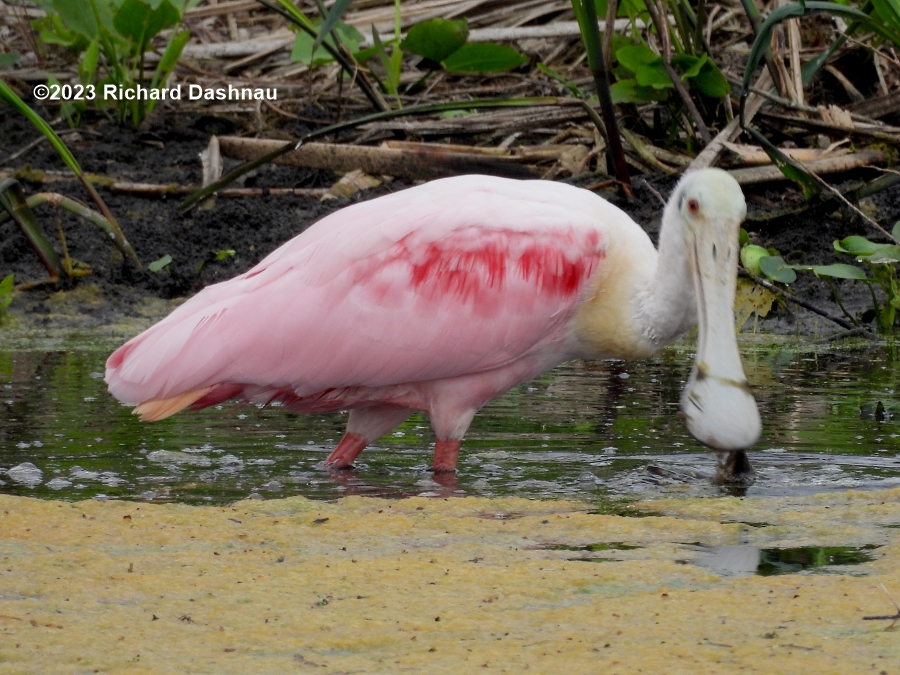
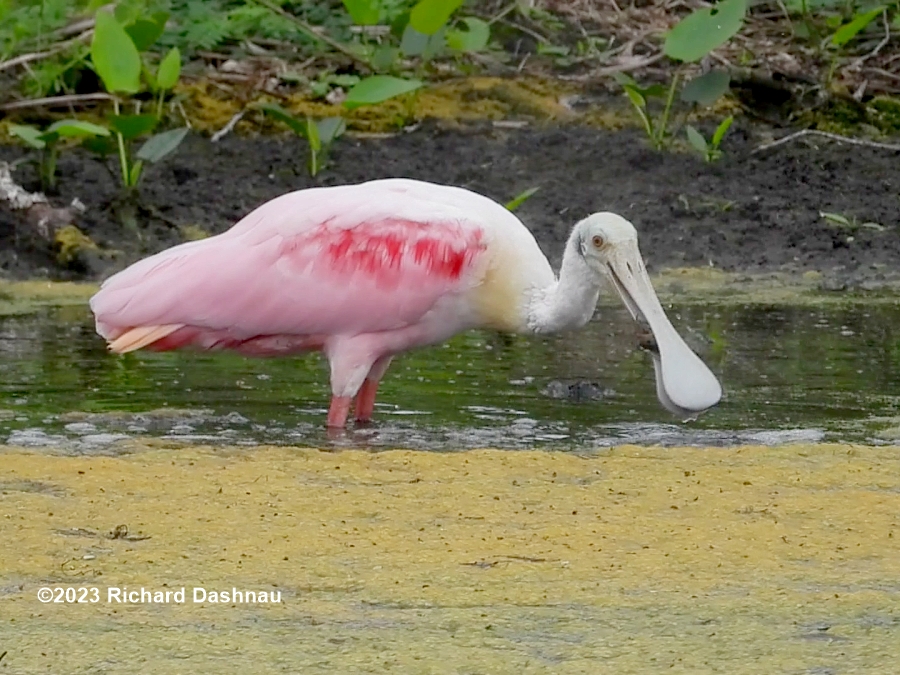
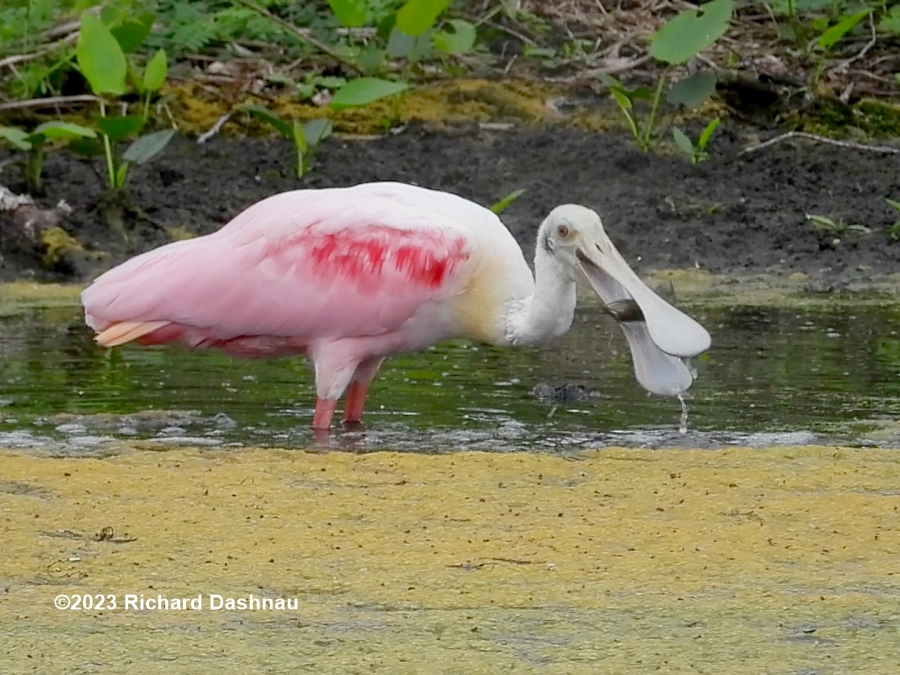
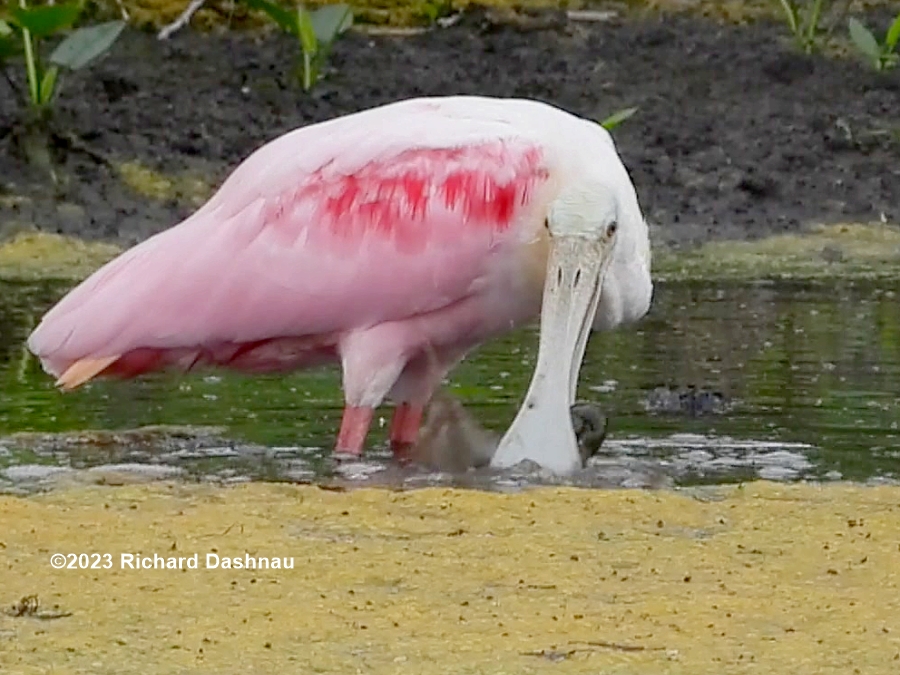
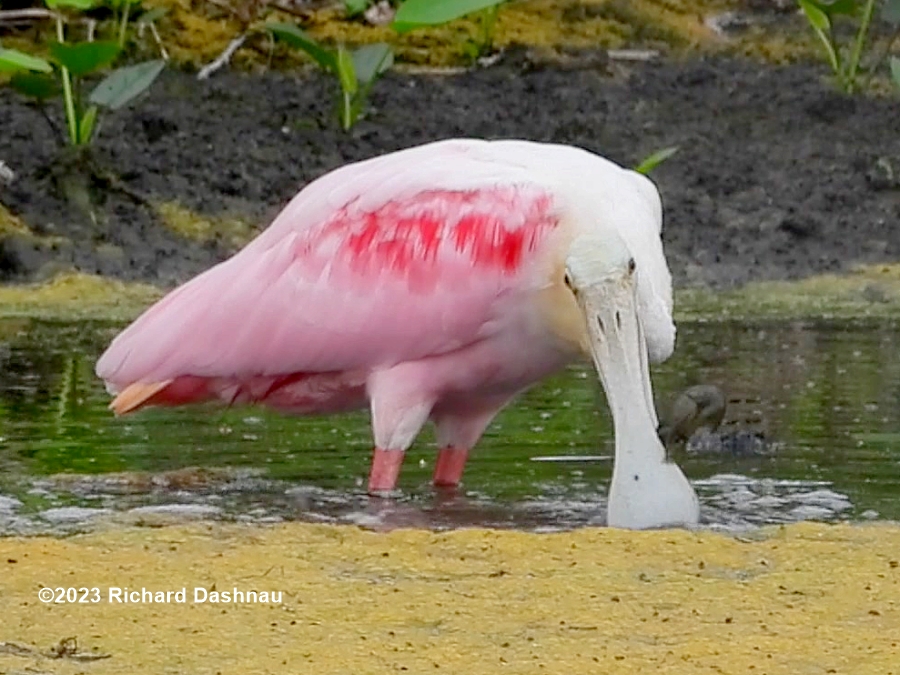
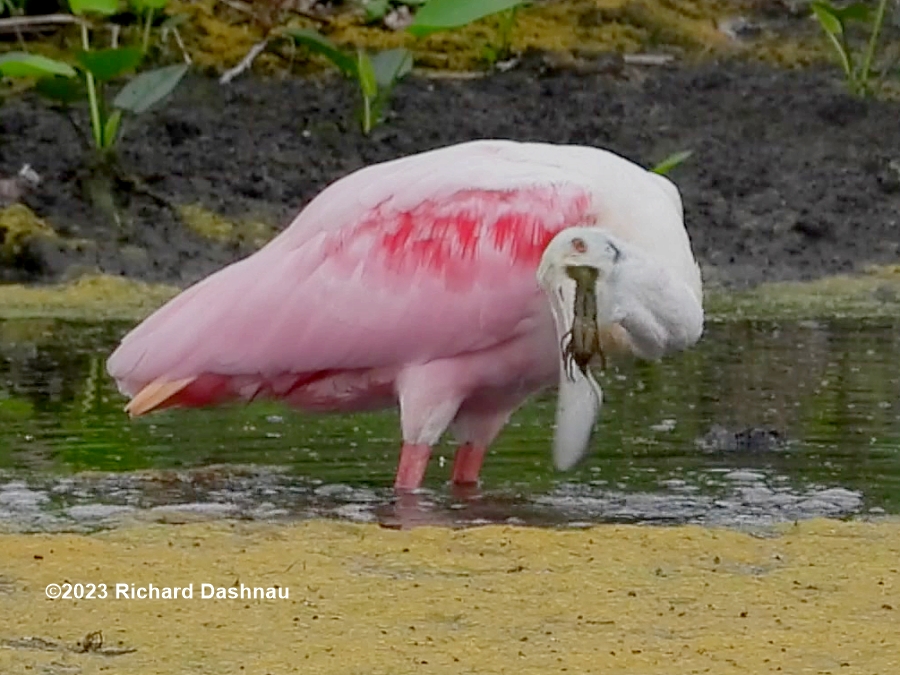
I have some of the clips playing half-speed so we can see it
foraging. I just like to watch Spoonbills at
work. Algae was sometimes coating its beak when
it left the water. Then
the Spoonbill
encountered a bit of "traffic". This
Snowy Egret (Egretta thula)
was moving a bit slower, but looking for the same kind of
prey. It has a yellow face and the bill is black, so it was
not a young Little Blue Heron.
(Egretta caerulea)
That's
also visible in the video clip.
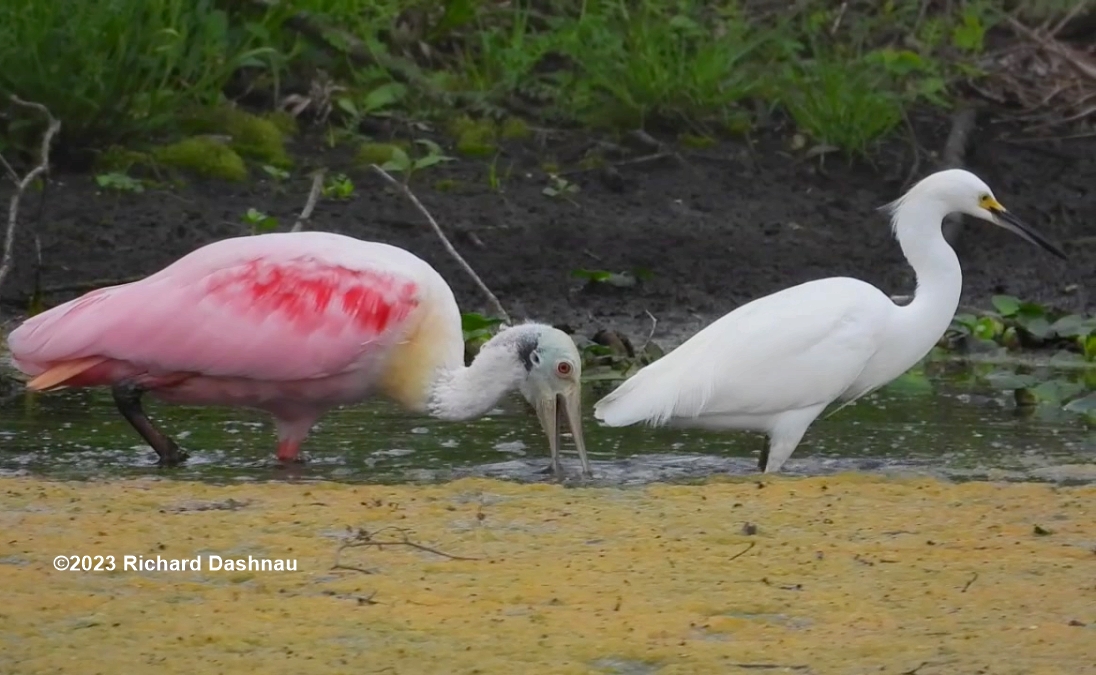
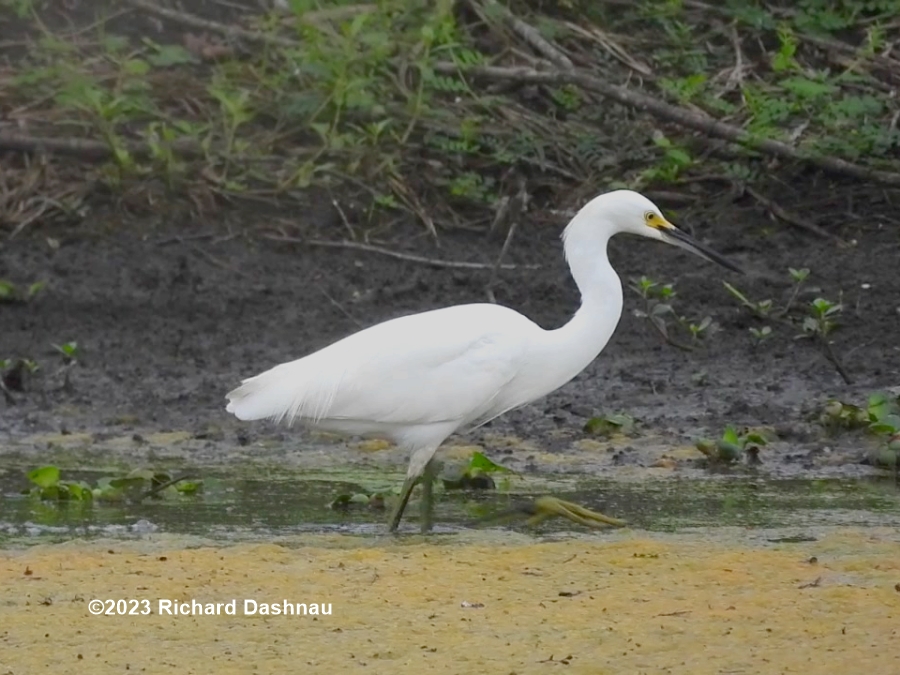
From
BBSP on 07/03/2022 We'd had many
Roseate Spoonbills nesting in Pilant Lake this spring. By this
time, the juveniles were large, but they still begged the
adults to feed them. This
Juvenile was with an adult on an exposed mudflat island. The
juvenile bobbed its head when approaching the adult, and if
the adult stood still long enough, the youngster poked the end
of its
bill at the joint of the adult's bill. Sometimes, it was fed.
This was at the beginning of the drought I describe on
this page.




From
BBSP on 06/12/2022 While
passing
by the wading bird rookery at the West side of Pilant Lake, I
noticed these two young Roseate Spoonbills. They were
perched on top of the branches, and were both flapping their
wings, almost in unison. I stopped to watch. They rested,
flapped, rested, seemed to chew on something hidden among
the leave, the repeated the drill. They seemed to flap their
wings faster in each bout. I thought they might be practicing
for flight, so started filming. After a few minutes, one, then
the other
took made a short flight (about 8 feet or so) to the next tree.
One jumped down a few branches and started poking around, while
the other one turned around and went back for another
successful flight. The images below show them during their
warmups. The video is here(mp4).
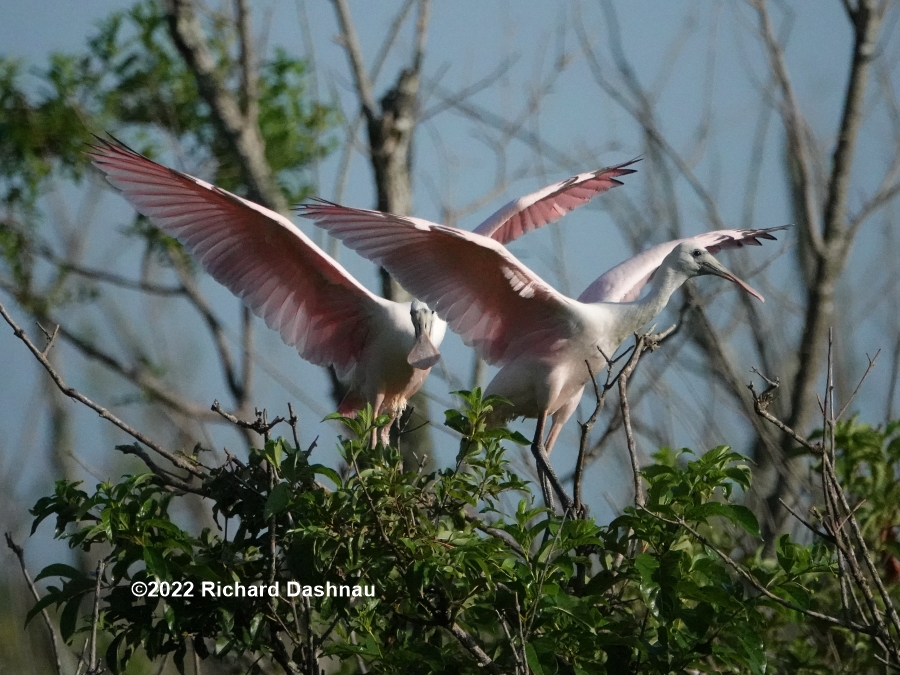
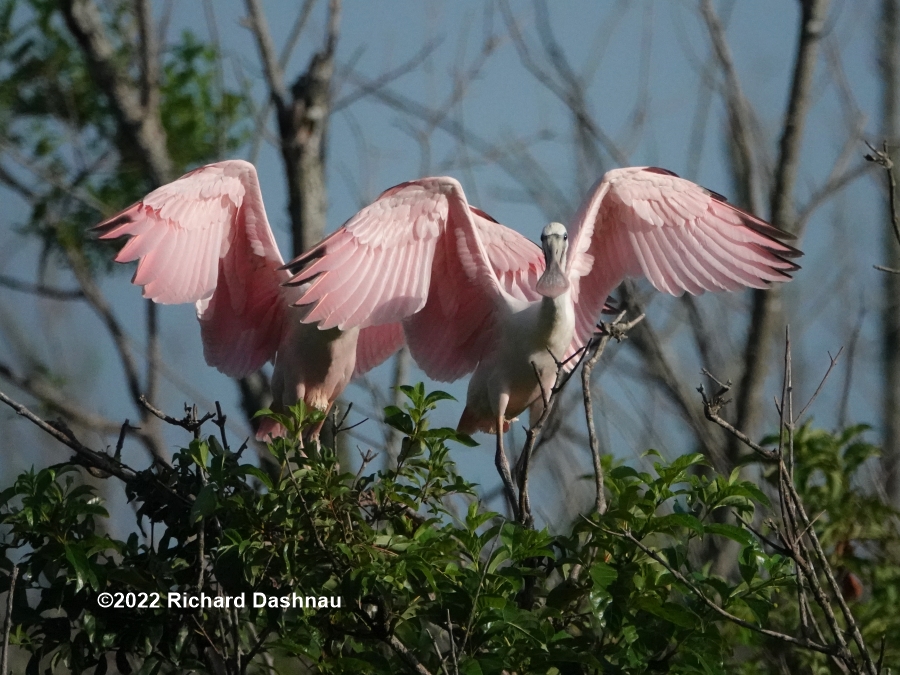
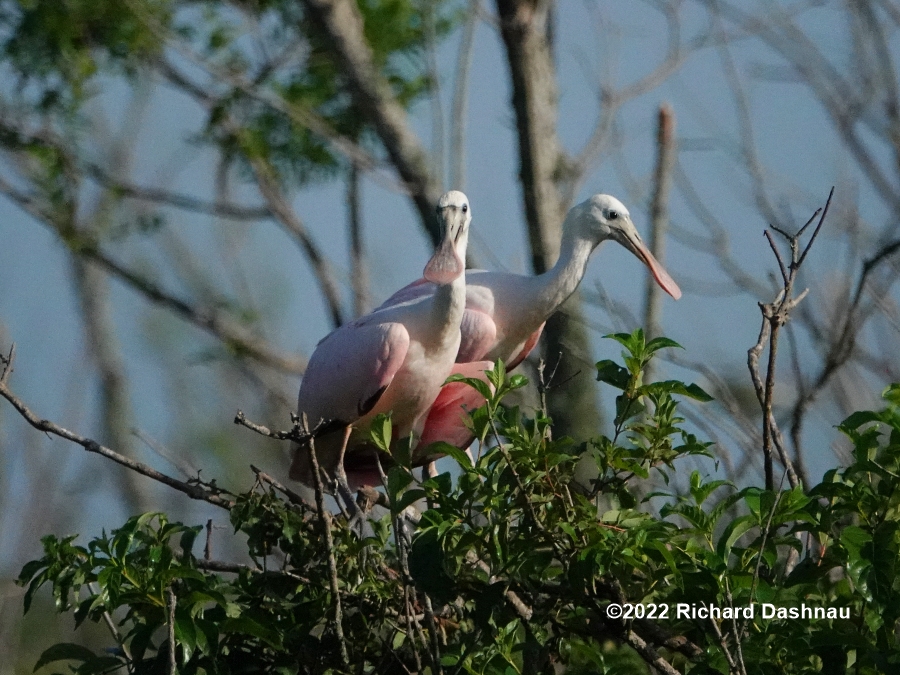
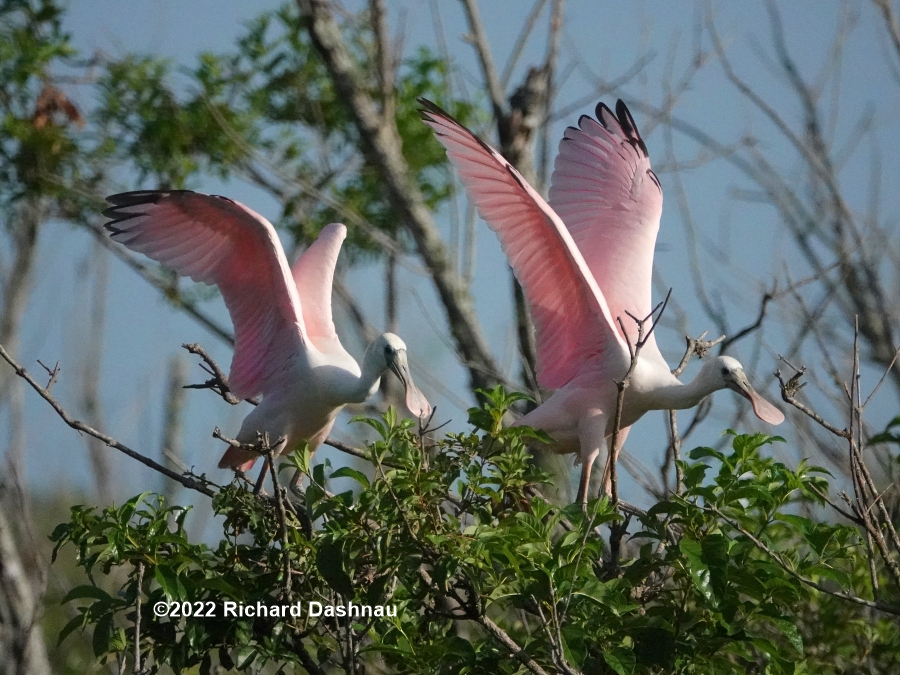
From
BBSP on 06/05/2022
Due to trail construction, lack of rain, and the heat, the water
level in Pilant Lake has dropped dramatically over the last
month or so.
The Spoonbill chicks' bills are
starting to get their...spoons.
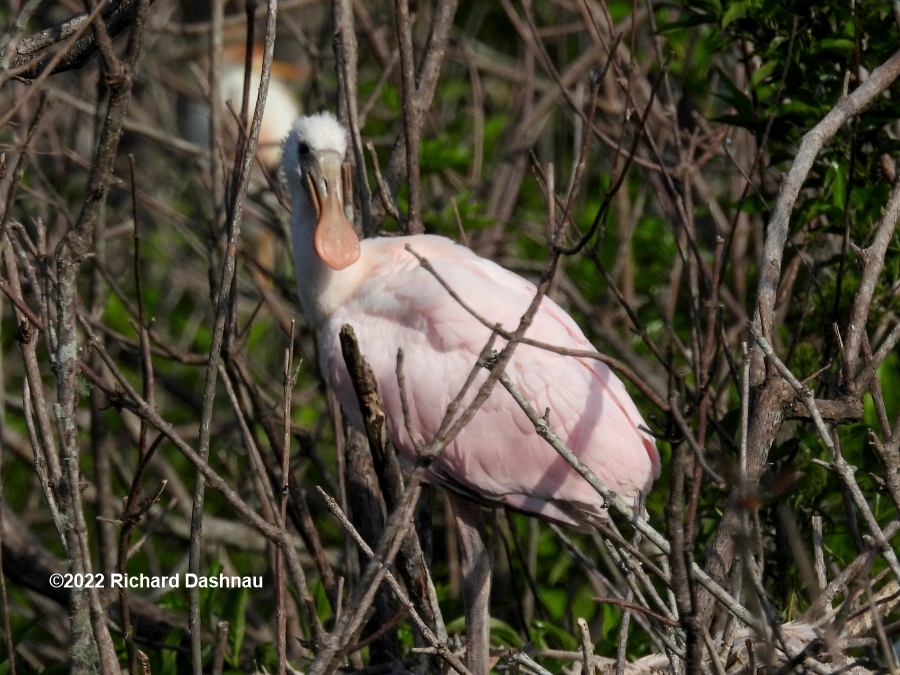
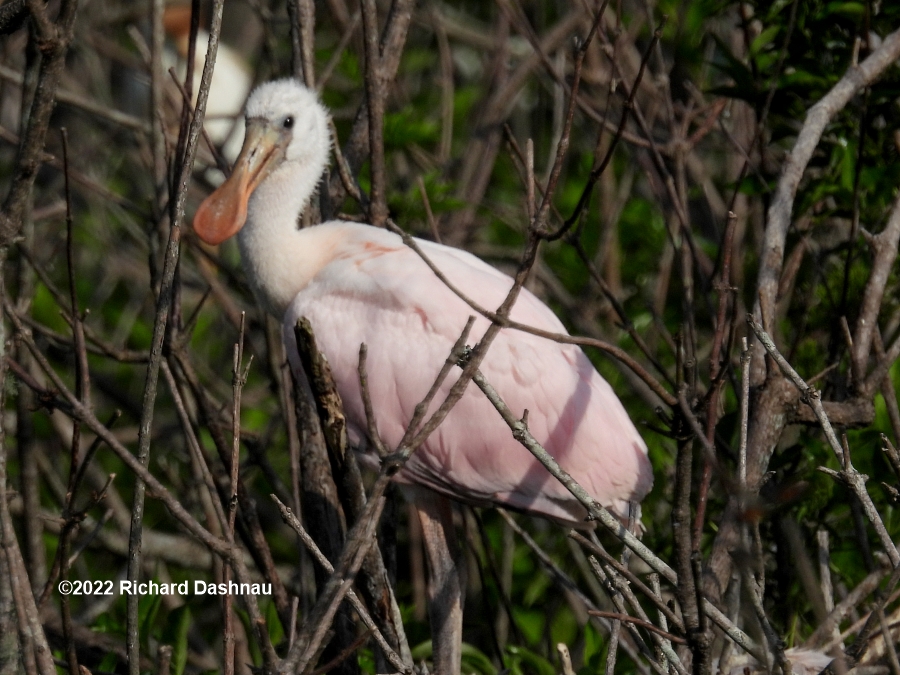
From
BBSP on 05/15/2022
Springtime at BBSP has been quite pink lately. The pink
that is bringing happiness is carried on the back of the Roseate
Spoonbills that have nested among the
other birds in the "rookery" that has grown on the West
side of Pilant Lake. BUT--on this
day, there were chicks! Spoonbills, sitting on nests, with
chicks, in Brazos Bend State Park, about
30 yards away from the trail. WOW!
The nests all the waders there are secured within the branches
of the trees. But, I was able to find a gap in the
branches and shoot through it enough to see the chicks while
their parent
took care of them. I tried video too, but I haven't even
tried to do anything with that yet (maybe later, and I'll update
when I check it). I was really happy to get these!
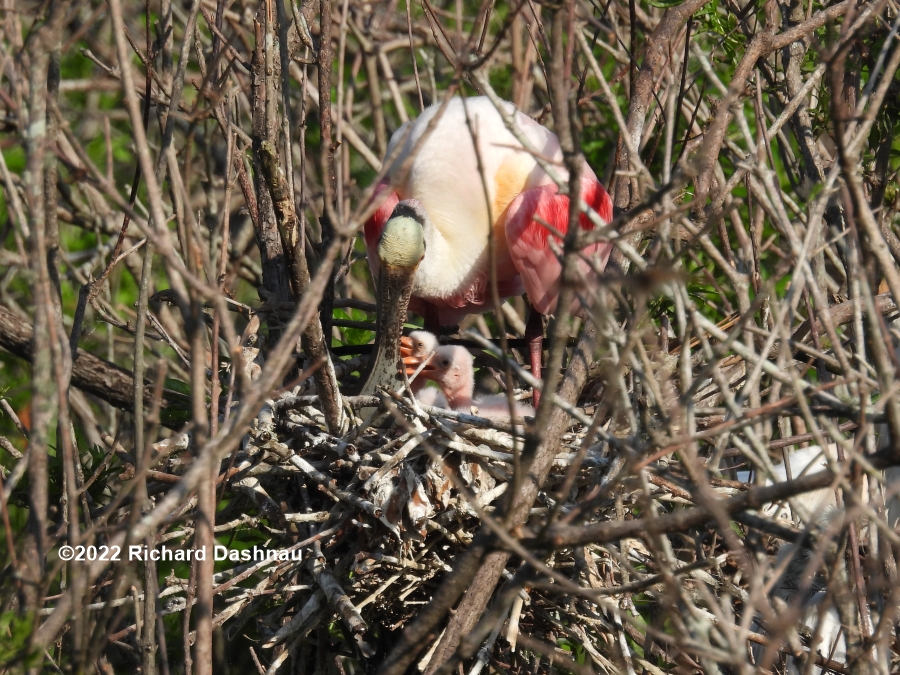
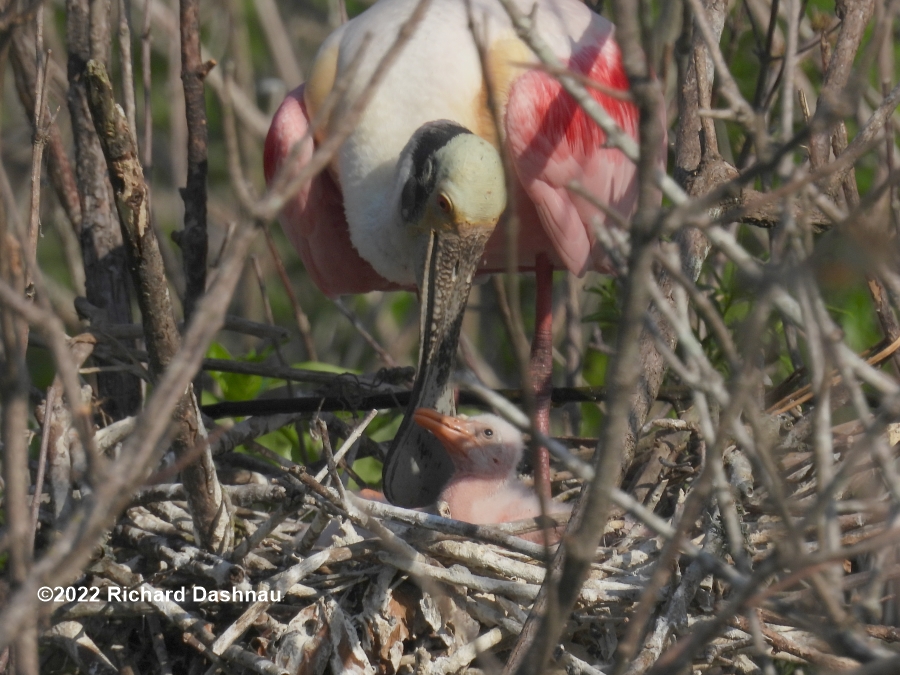
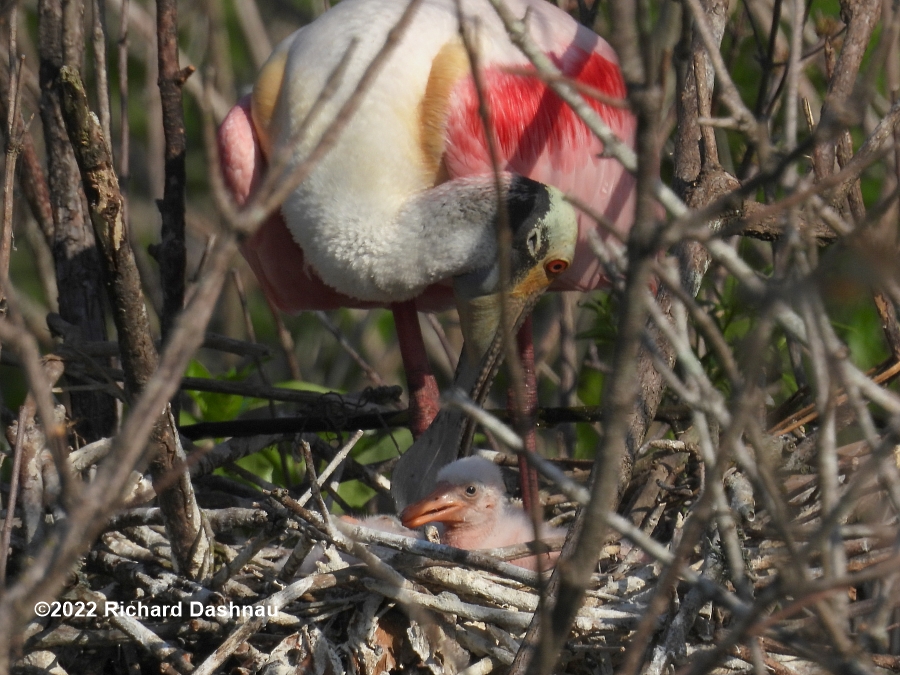
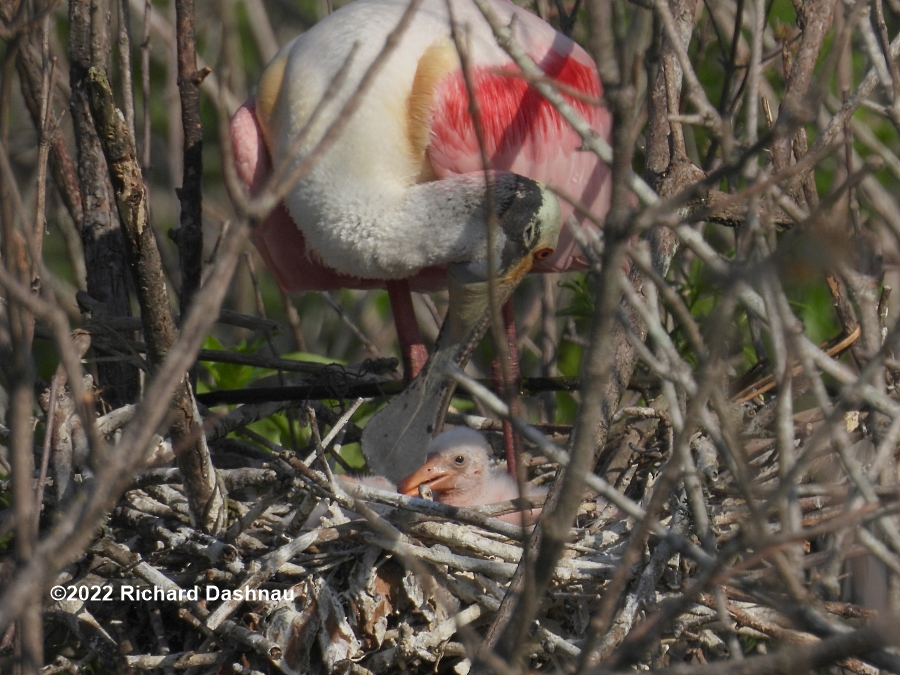
More
pics of the mom Spoonbill and babies.
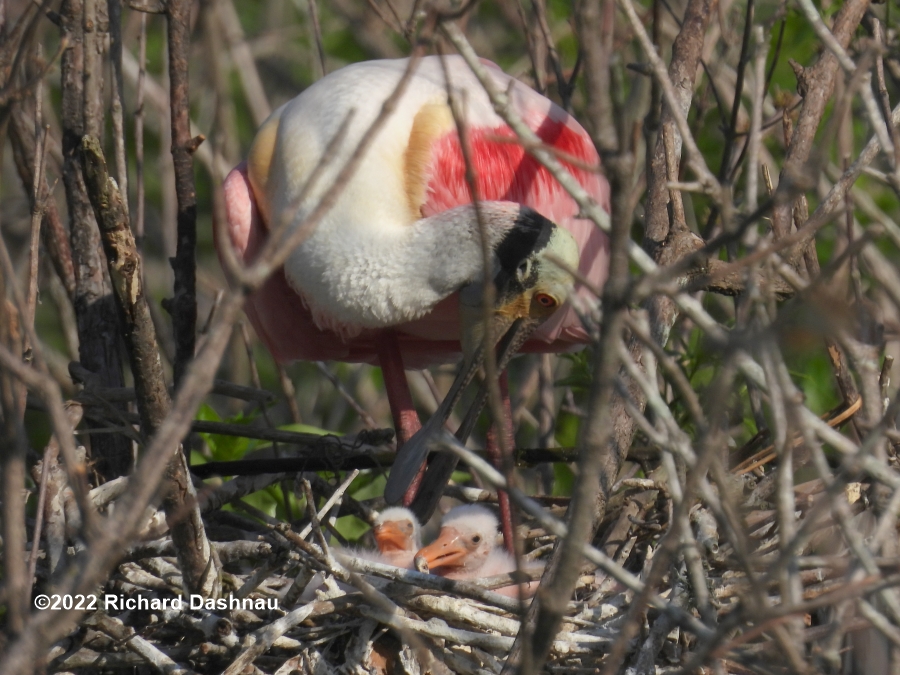
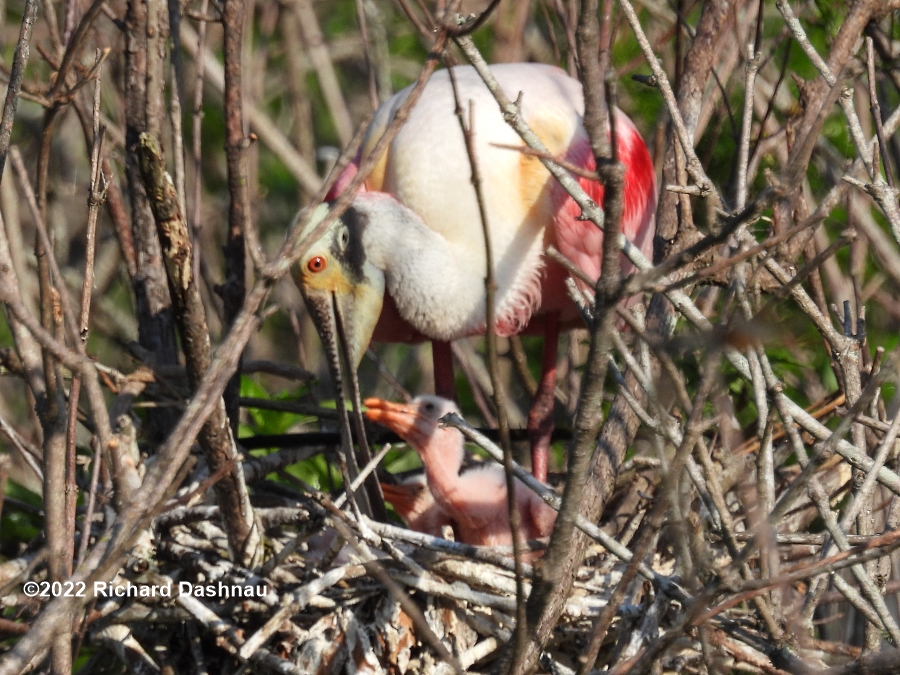
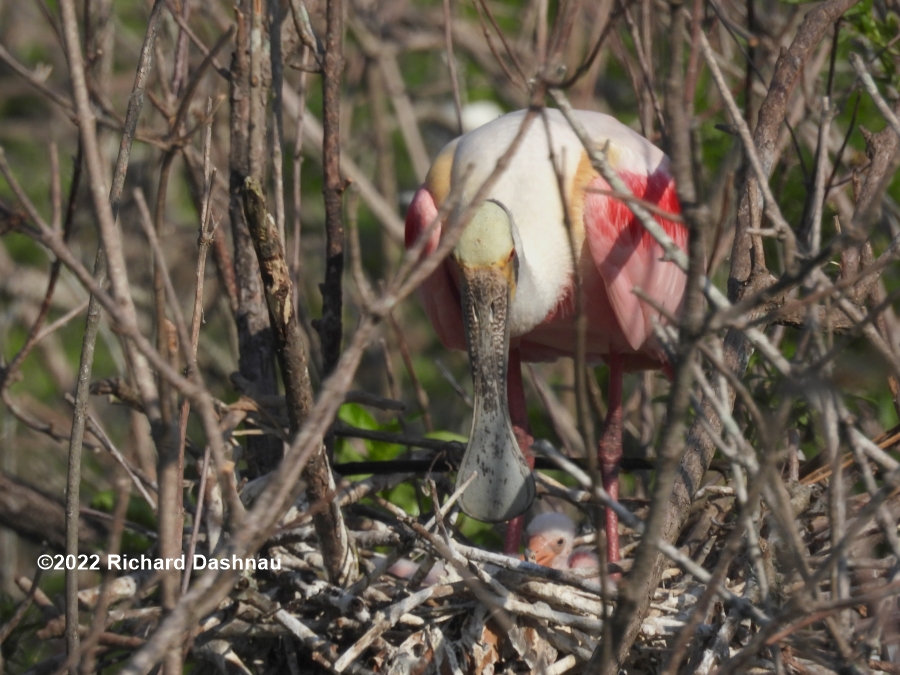
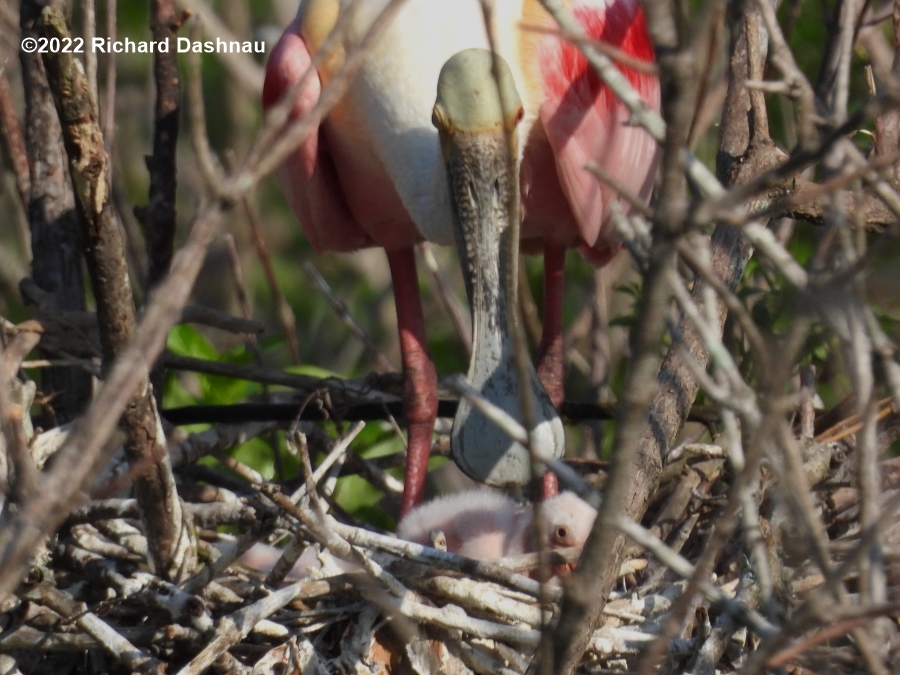
Update
05/20/2022-- When
I reviewed the video, I found only 47 seconds of good footage.
I've edited it into this video, with a replay slowed 3 times.
The images below are frames from the
video--where
we watch one of the nestlings get fed. Over the 20
years or so that I've been volunteering at BBSP, I've talked to
hundreds of visitors about baby alligators--many times while
we were watching a pod of them out in the wild. Many folks
have asked if the mother gator feeds the babies, and I say that
after they absorb their yolk sac, the babies forage for
themselves.
Some of people ask why the mother gator doesn't feed the babies,
and I'll usually suggest that any prey large enough for the mother
gator to notice and catch would be too large for the baby
gators to eat. Out of all those hunrdeds of people--one
visitor suggested that the mother gator could regurgitate-feed her
babies (like the Spoonbill is doing here). What a cool idea! I'd
never
thought of that! At the time, I just said that I had never
seen anything written-or observed myself-anything that suggested
that alligators could do that. But I had to think about it.
This Spoonbill
is feeding its nestling by using material stored in its crop.
In birds, a crop is a sac or pouch that food can sit in on
its way from the mouth to the stomach. We can see the nestling
poking its
head into the adult's throat until it can reach that stored food.
Alligators don't have a crop, and their esophagus is
long--it has to reach the stomach which is pretty far to the rear.
So, alligator
moms can't feed their babies this way.
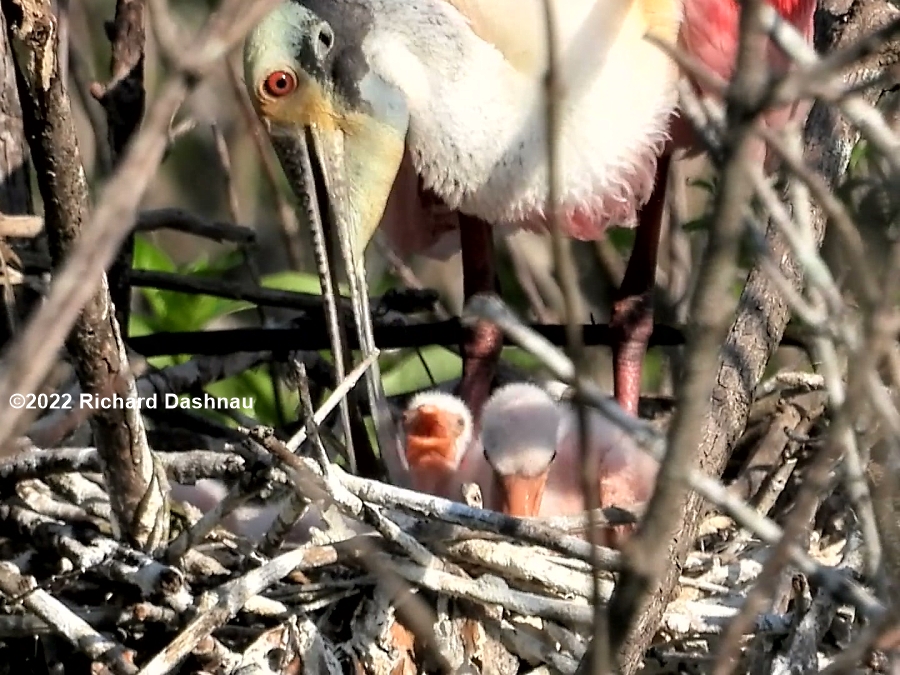
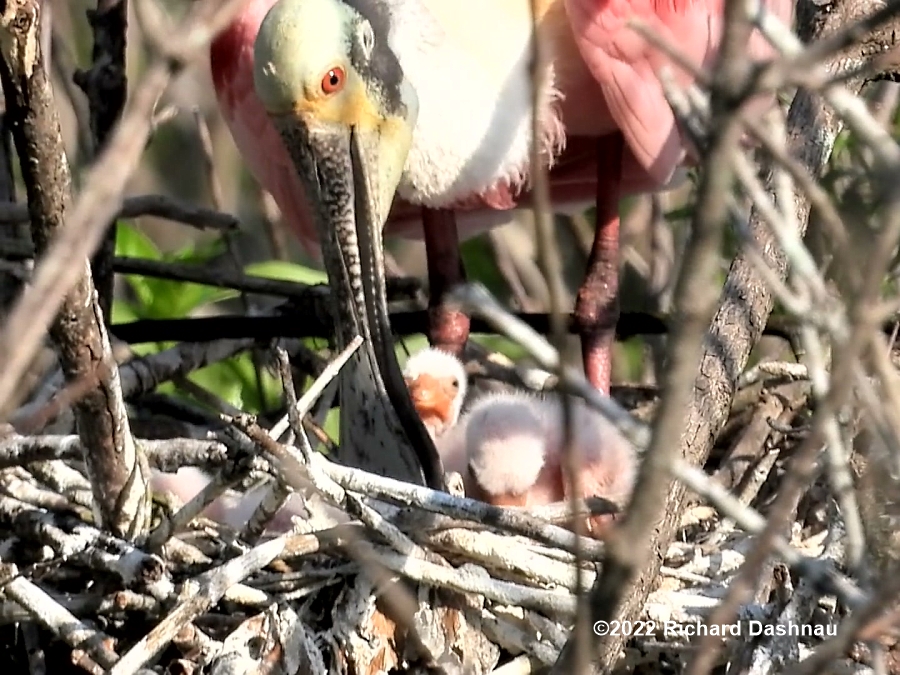
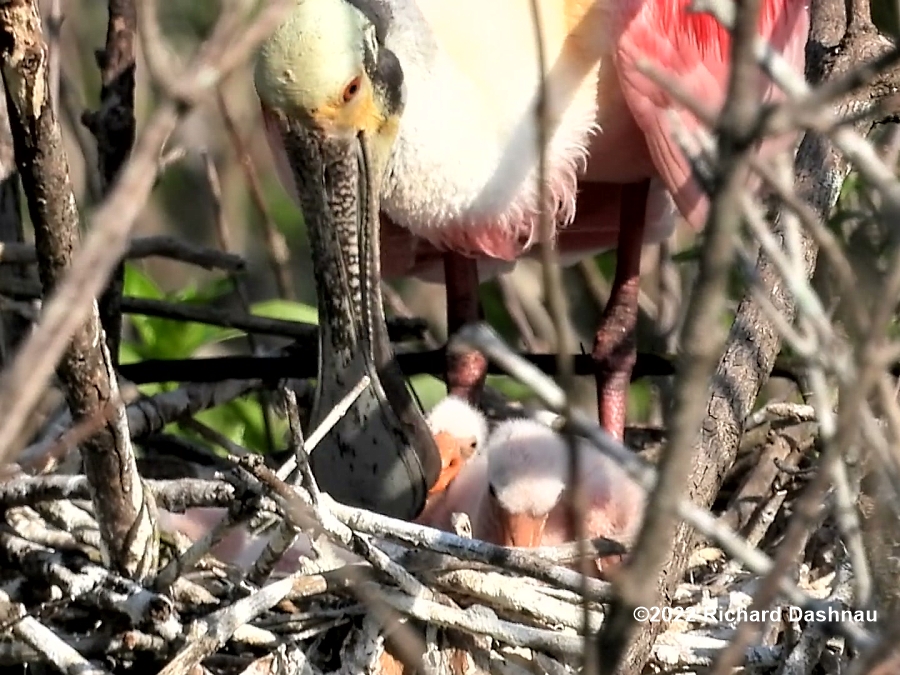
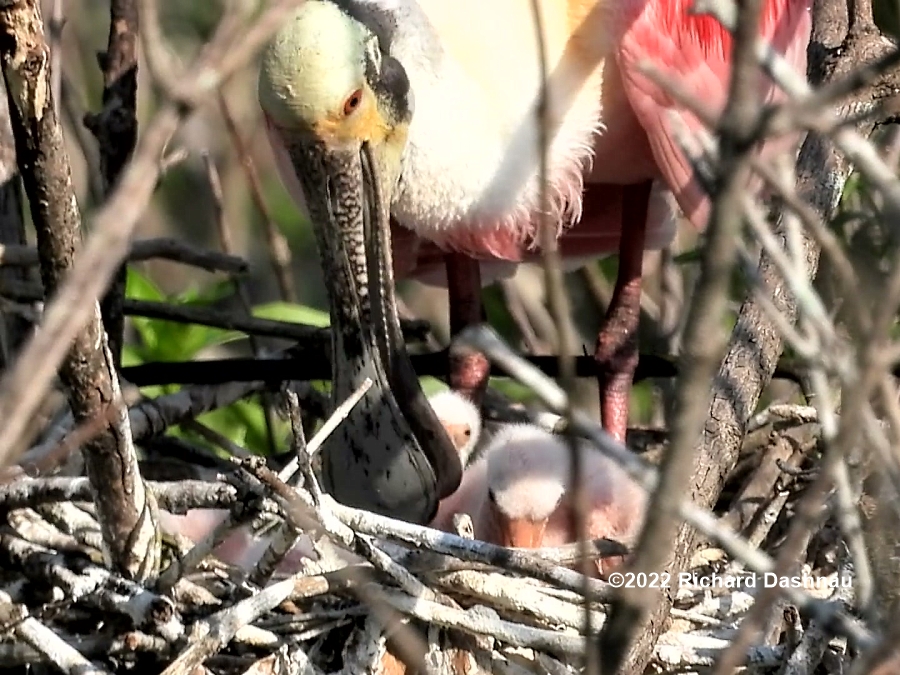
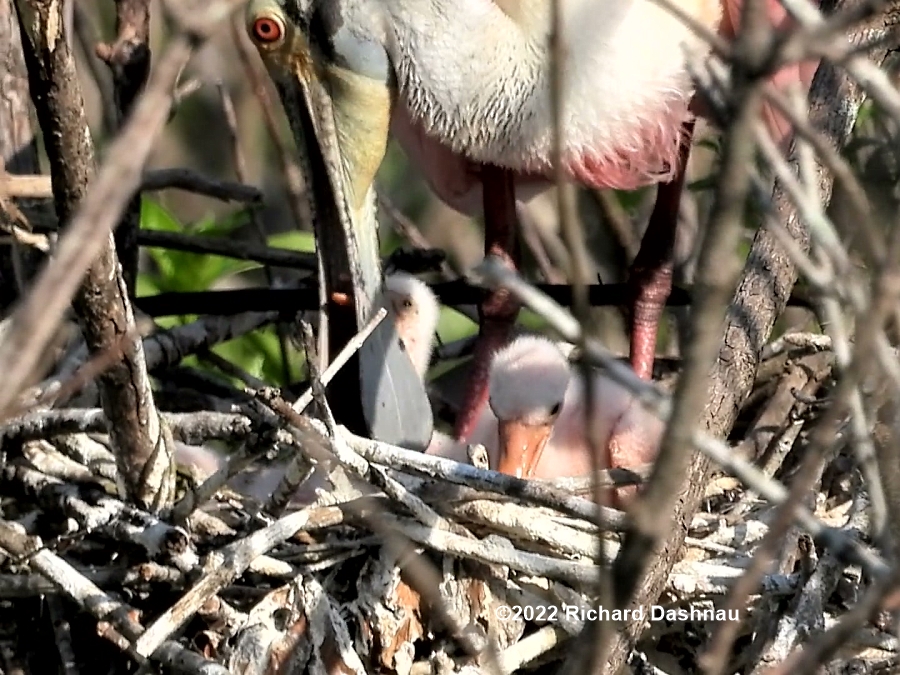
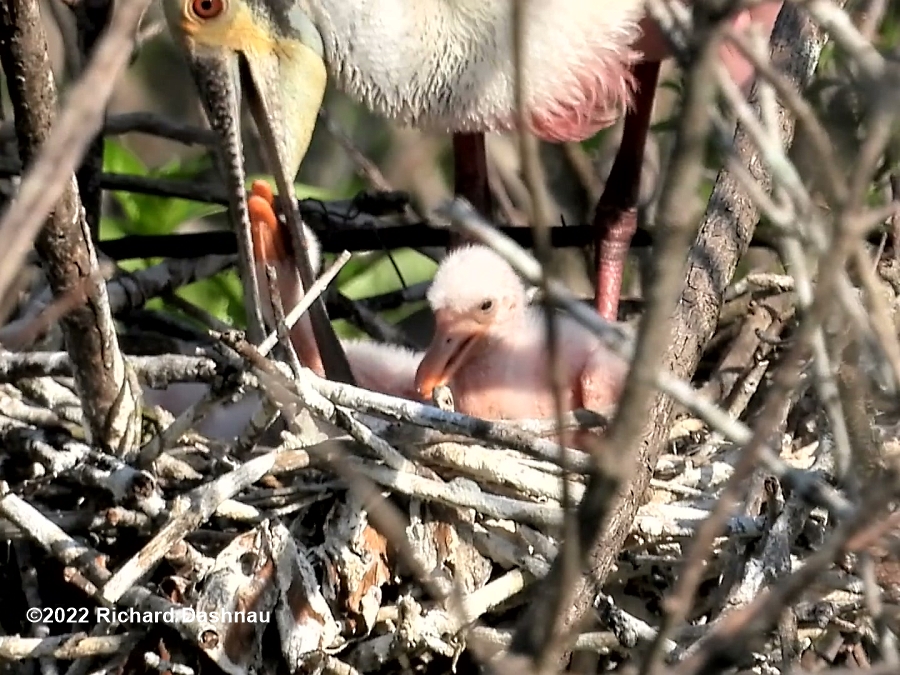
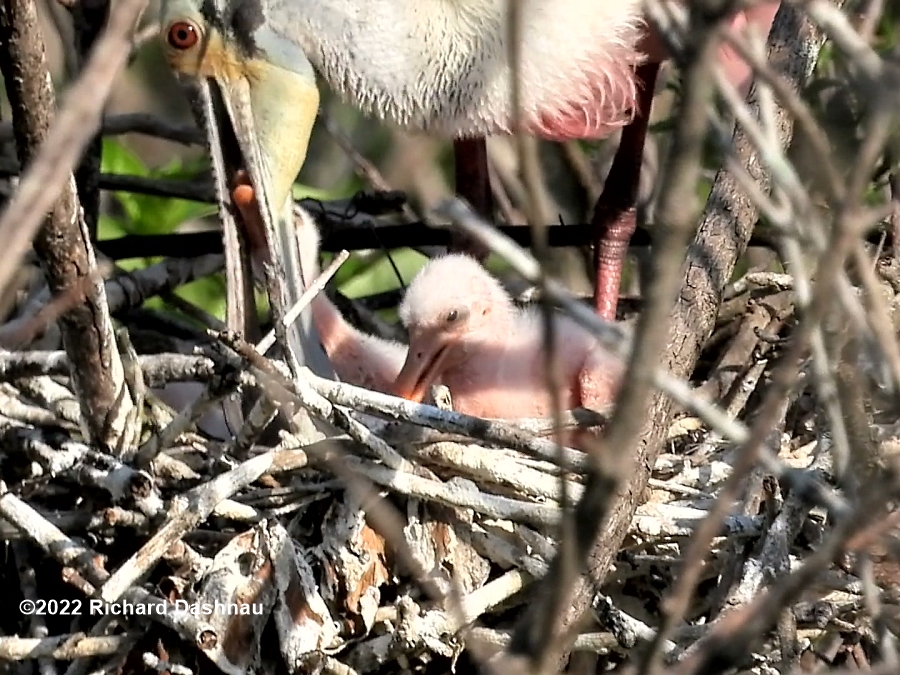
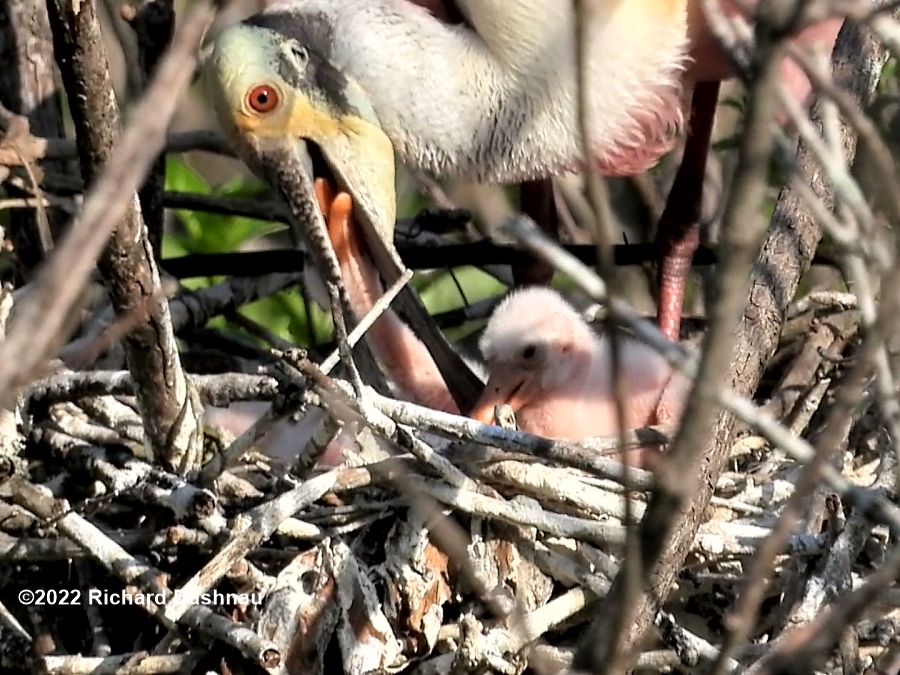
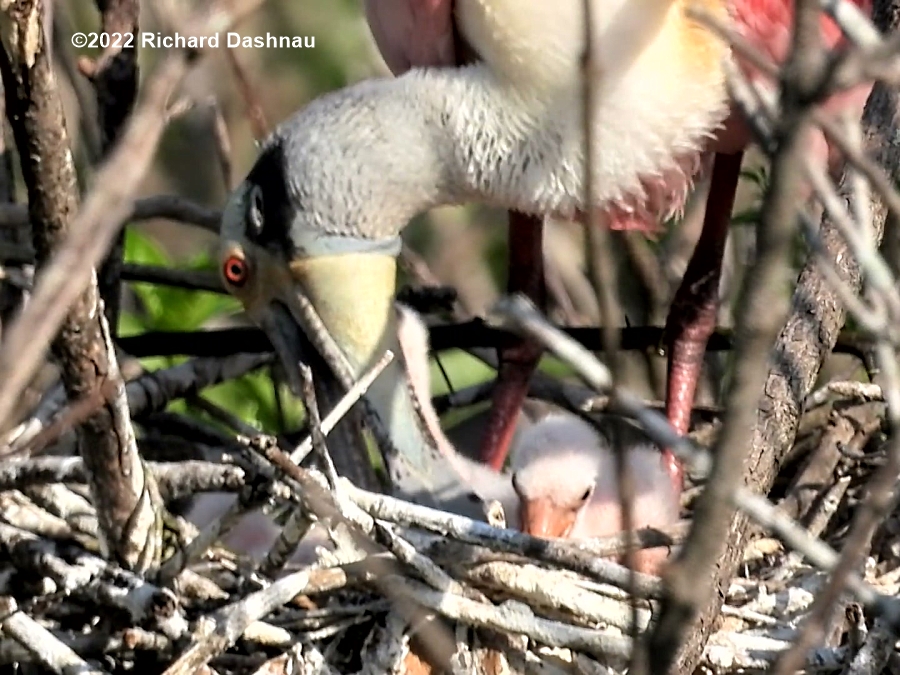
04/24/2022.
Springtime has brought new life and activity to the park.
I
mentioned Spoonbills at the beginning of this entry. Around
3:00, I saw them flying from the nesting area (rookery)
at
the West side of Pilant Lake to the islands in 40 Acre Lake. I
watched them for a while while they prospected for branches. I
didn't see any feeding activity. When they dipped their bills
into
the lake, they seemed to be looking for branches and twigs (at
least that's what they came up with). So here are some
pictures of the Spoonbills. Spoonbill 01 below is opening a
branch
office. Spoonbill 03 is photo bombing some Black-bellied
Whistling Ducks (or vice-versa). I've also got this short video showing the spoonbills
at work, and a bit of stick stealing. So many
wonderful birds at BBSP!
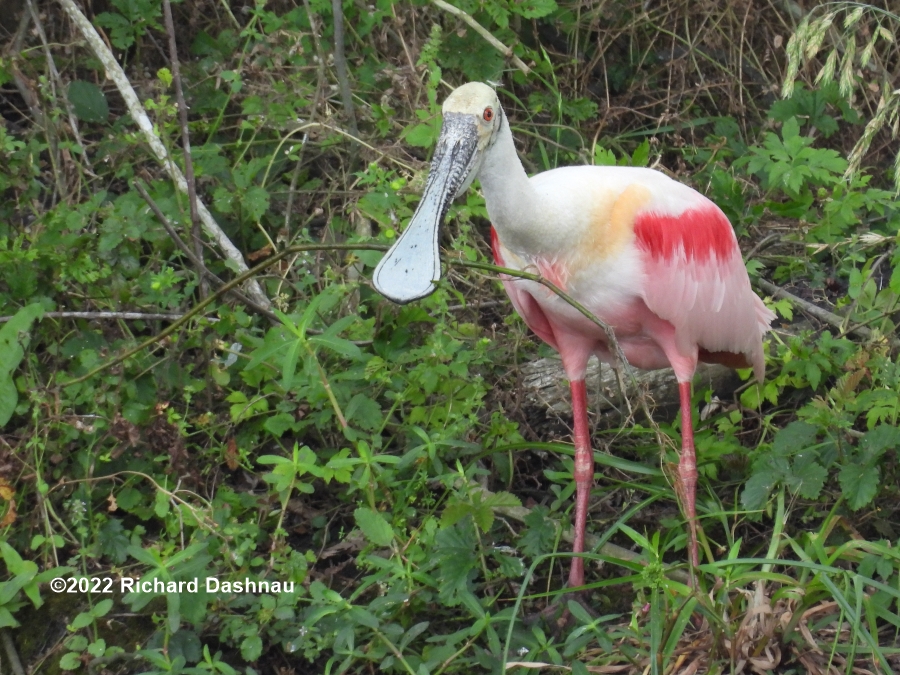
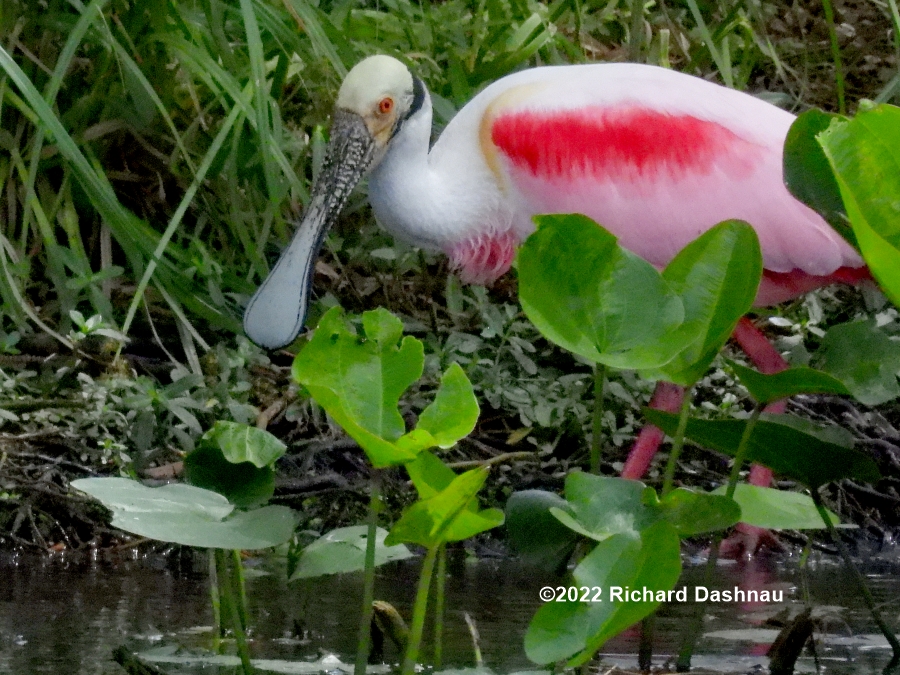
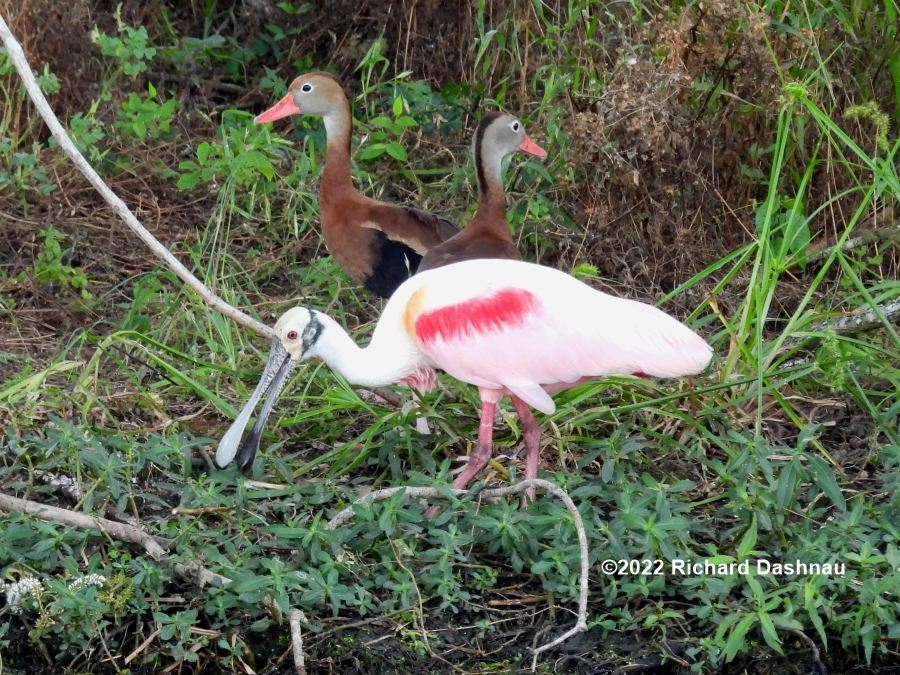
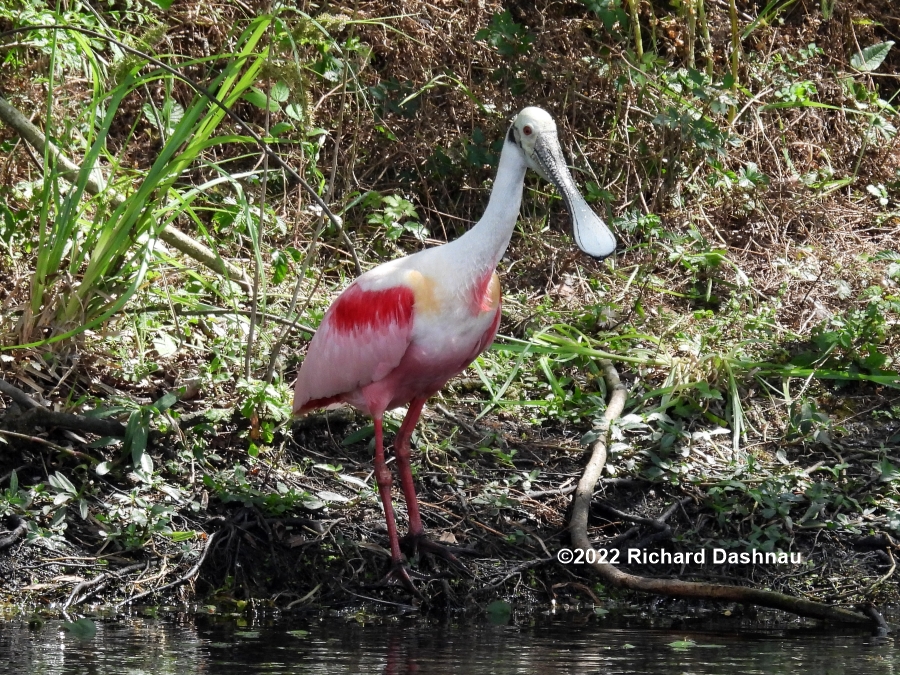
03/06/2022. Around
8am,
the air was 72°
F-compared to 34° F a week
before! Roseate
Spoonbills
(Platalea ajaja) landed in trees West end of the island across
from the Observation Tower.
Spoonbills are beginning to build nests in the "rookery area"
that has developed on the West end of Pilant Lake over
the last few years. While building the nests, they are
foraging nearby for
branches and other building materials. If I'm lucky, I get to
see them poking around on the islands in 40 Acre Lake. The
first series of 4 images below show one of the Spoonbills
pulling on one
of the branches...only to discover that it was still attached
to the tree. There was another Spoonbill near it, and I
might have been looking at a courting pair. During courtship,
Spoonbills present
gifts of nesting material to each other. That morning
was a bit overcast, which gave everything a "grayscale"
appearance, with colors all muted. In those
conditions, the Spoonbills almost seemed to glow!
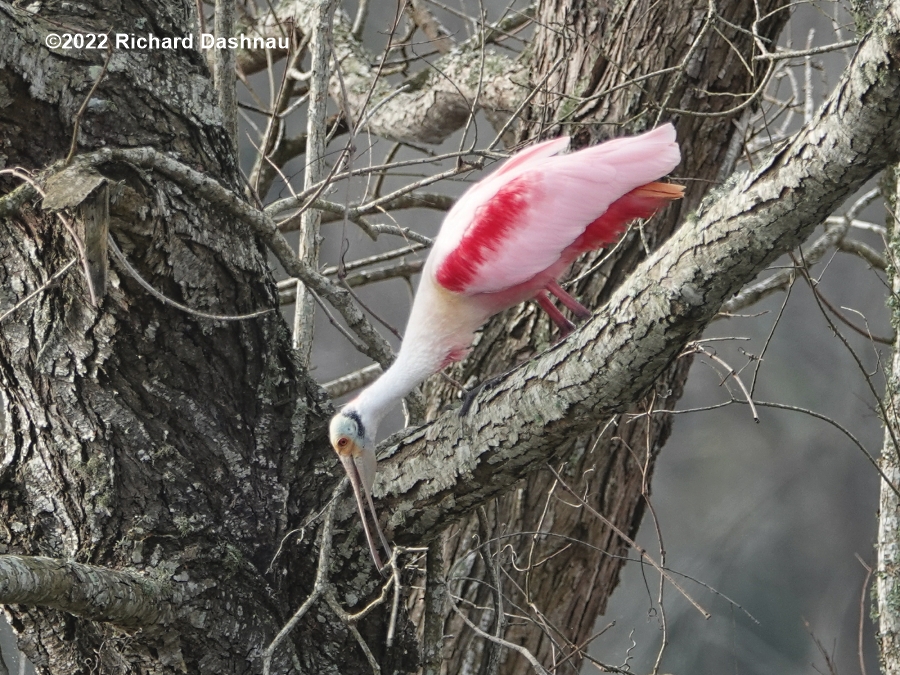
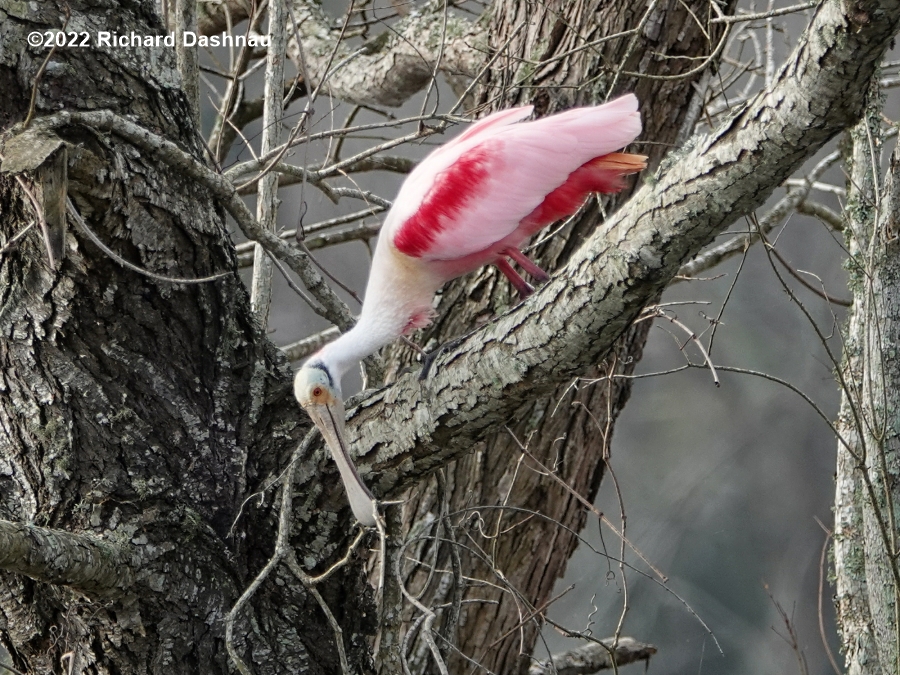
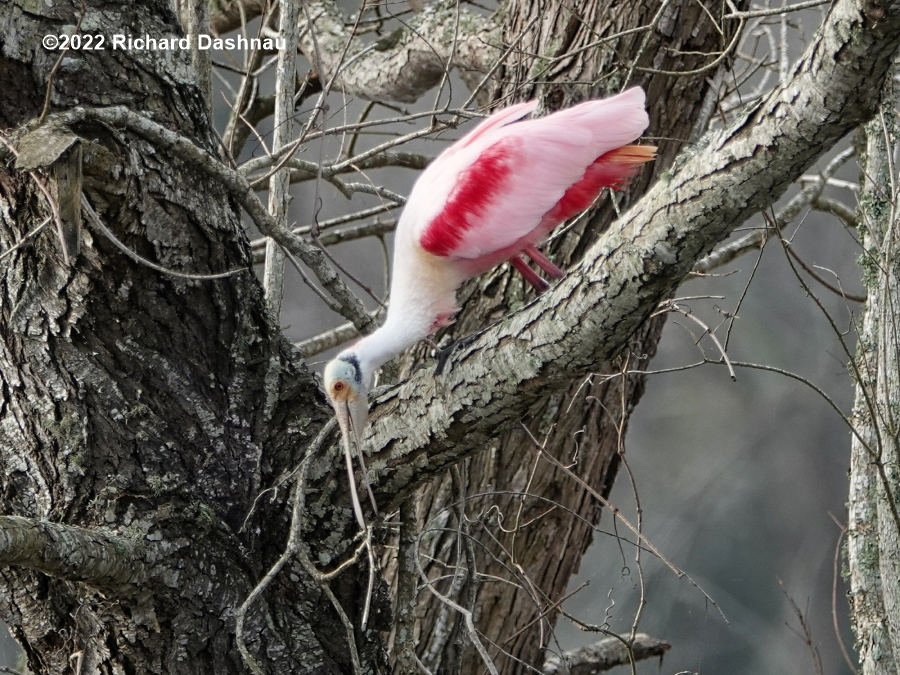
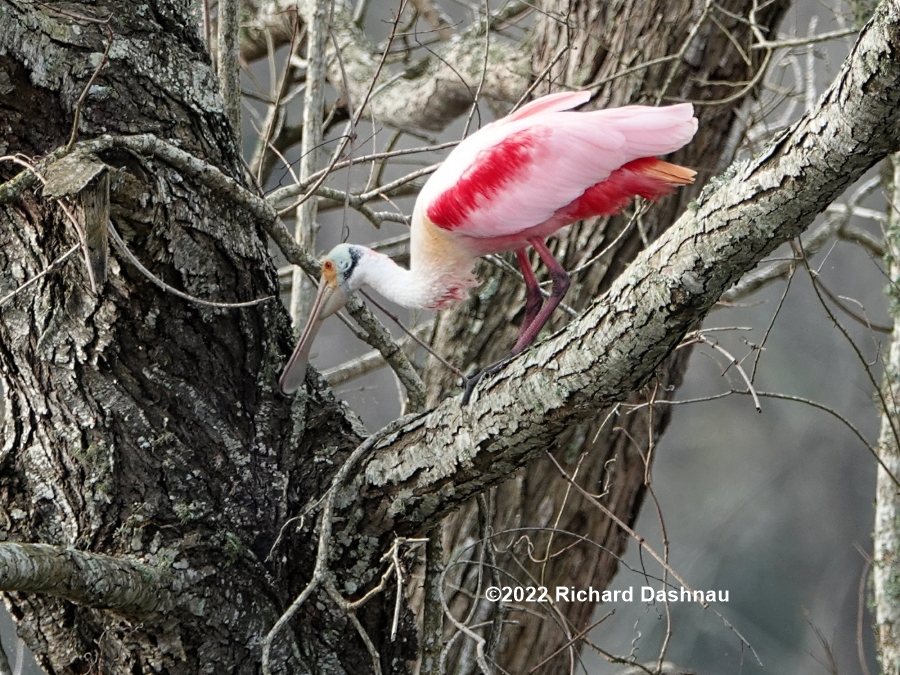
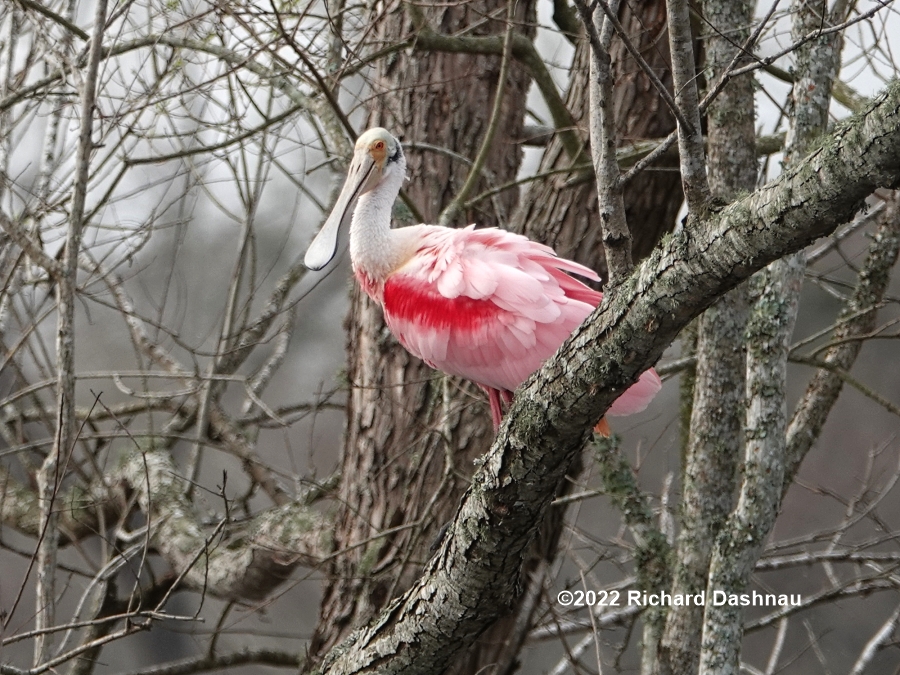
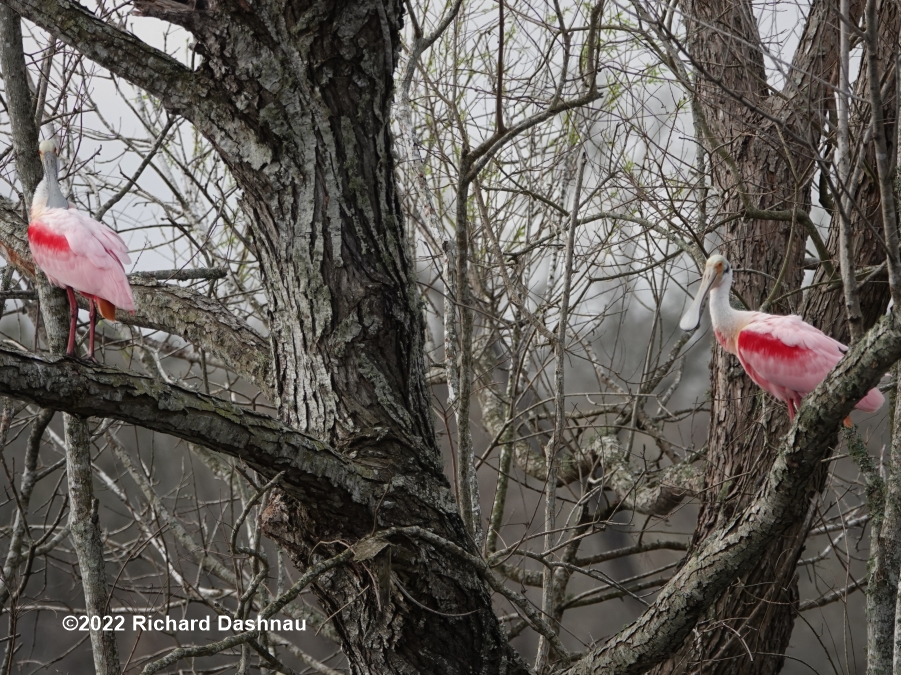
04/11/2021
I've gone to BBSP again!
It sure is great to be back. During 7 hours on the trails, I did
interpretation for about 80 people. Of course, there is lot to see while
I'm out there, and between question-and-answer sessions, I got to watch
the wildlife. Oh...and I'd also led a hike (the 80 contacts does not
include the hike total).
Over the past...maybe...5
years, wading birds have set up a rookery just North of the West end of
40-Acre Lake. This year, Roseate Spoonbills (Platalea ajaja) seem
to be nesting
in that area, too. So, throughout the day, I could see them flying from
Pilant Lake, across the trail, to the islands on 40-Acre Lake (and back
again). At the islands, I could watch them
forage, preen, bathe, argue, and gather sticks. This was best seen
through binoculars, or some other magnifier, because the islands are
about 50 yards from the trail. Spoonbills always
stand out, since they are large, and pink. Now, during
courtship/mating/nesting, their colors are sharp and bright. I
might have stayed there all day, but I needed to cover more
ground--and I'd signed
up to lead a hike. However, I passed through that area few times,
and enjoyed the view. The images below share some of my experience. I
also shot video which I edited into an 8
minute clip,
which can
be seen here. In the clip, there is some foraging, a few
bill-claps, a bit of feistiness,some stick retrieval and other
"Spoonbillisms". I've volunteered at
BBSP for about 20 years. During all of that time I've learned
that conditions of the park can change every year. Occurrences over
the season of one year might not be repeated again the
next year...and may never be repeated again.
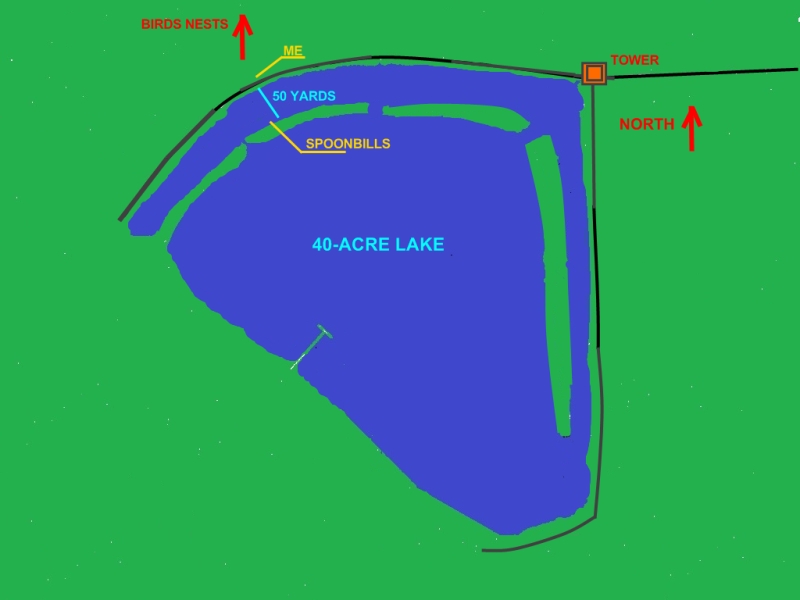
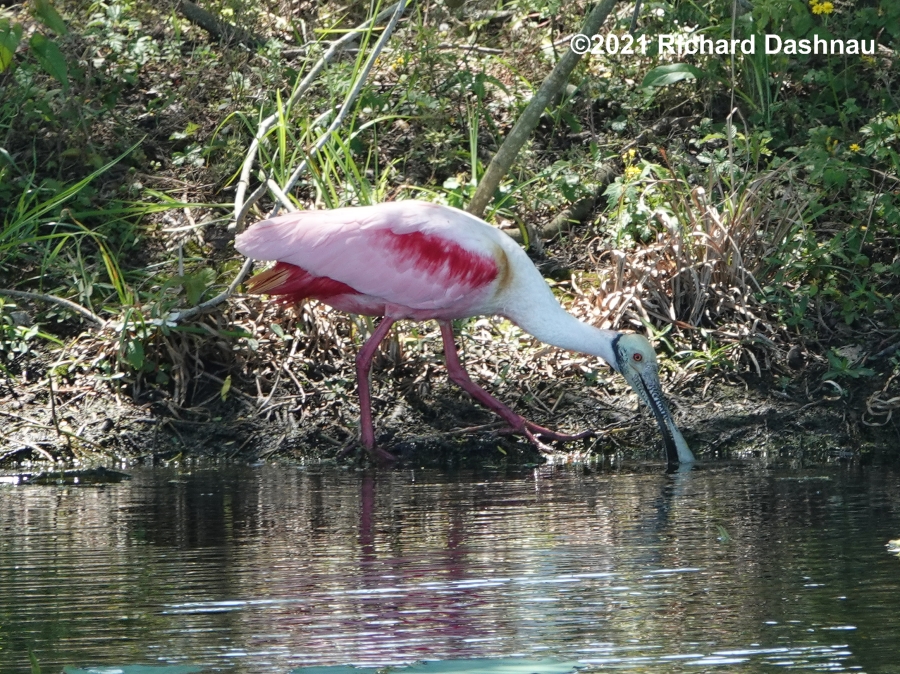
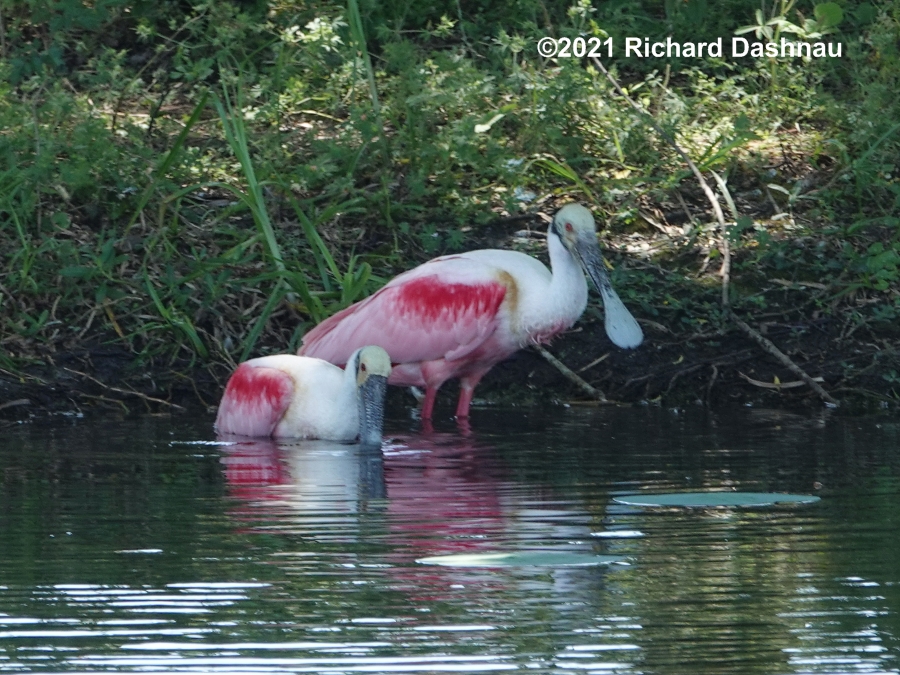
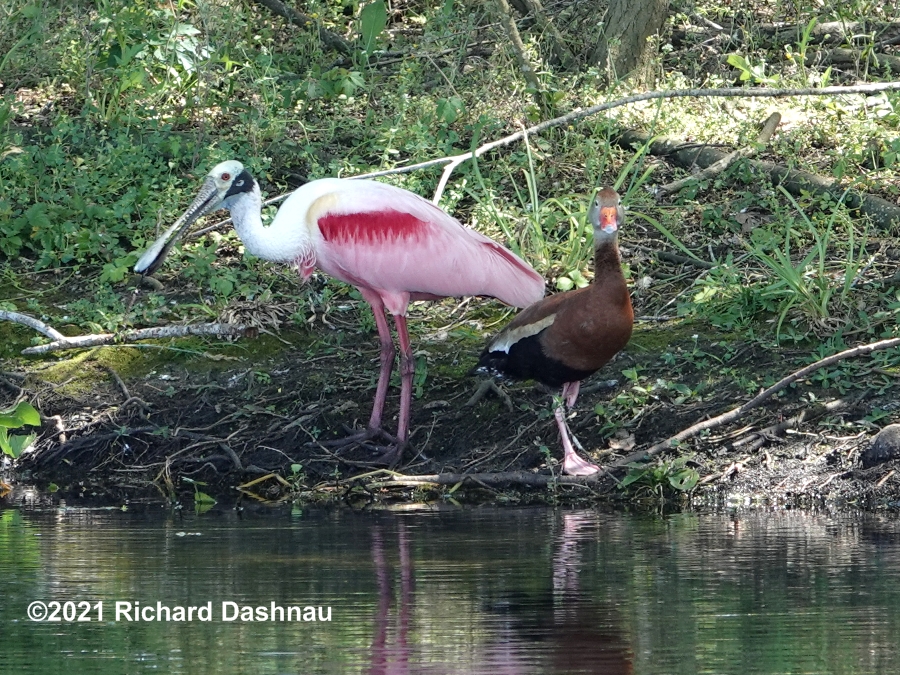
This is 40-Acre
Lake
With a
Black-Bellied Whistling Duck (Dendrocygna autumnalis)
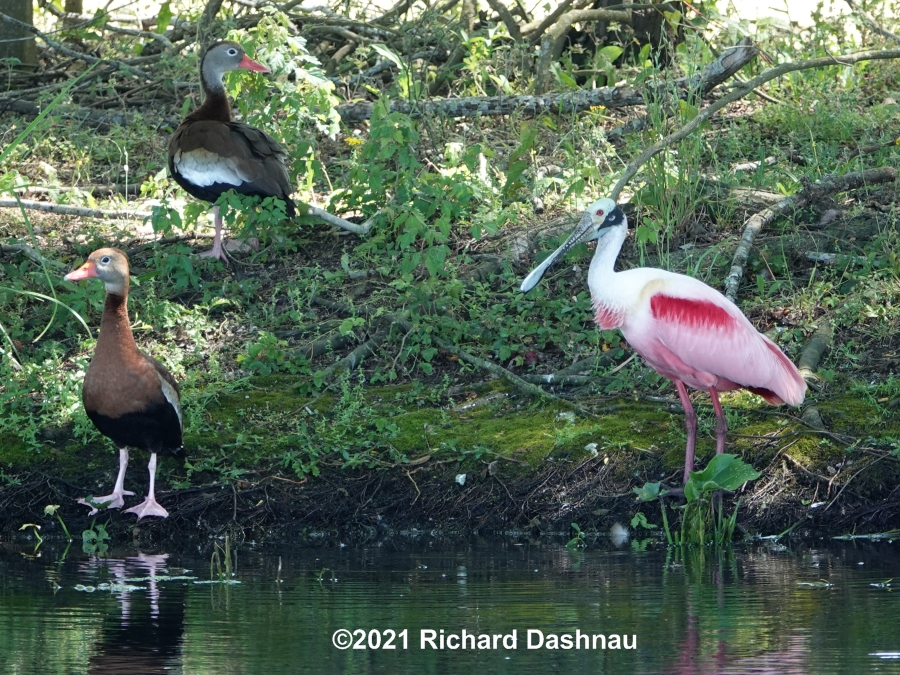
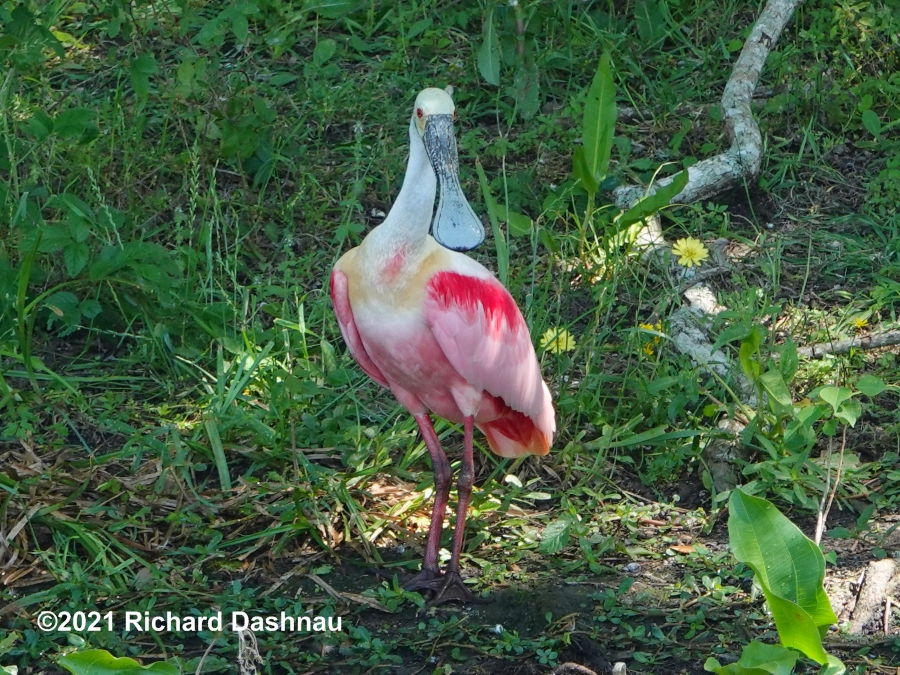
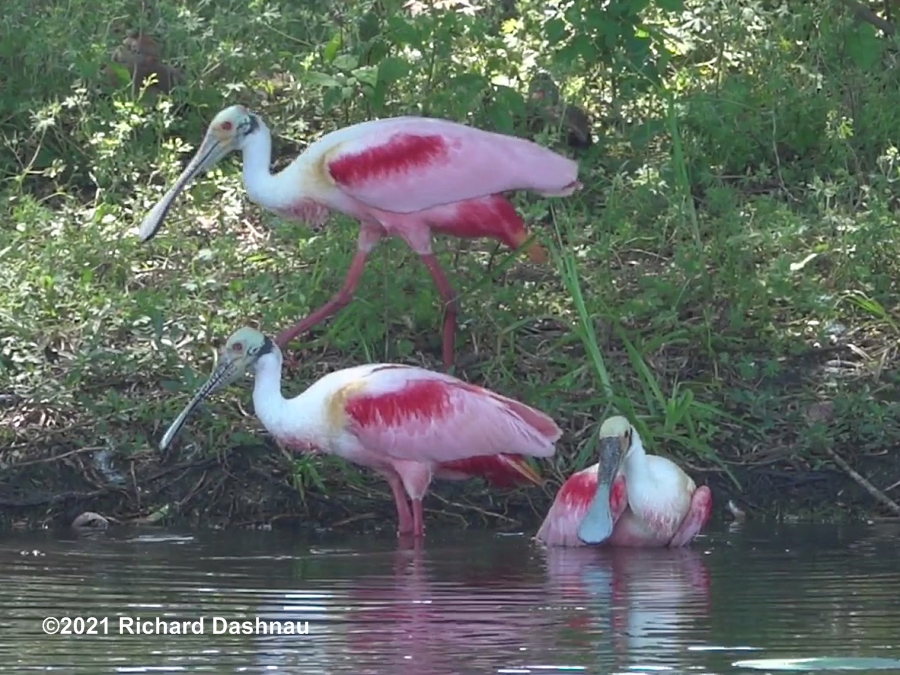
A frame from the video.
07/16/2006--From
time to time, a park visitor will come up to me and ask about the
"flamingos" that they've seen in the park. While larg, pink wading
birds do visit the park occasionally,
they aren't flamingos. They are Roseate Spoonbills
(Platalea ajaja). I've seen them from time to time, and there was
even a group of them staying on the 40 Acre Lake island for a few
weeks.
But I've never been able to get close enough
to watch them. Until today. We had
been favored with a little rain, and the corner of Pilant Lake near
the Elm Lake water station had filled
nicely. A few Spoonbills were
foraging in the water, and to my great satisfaction, they allowed me
to take some pictures and video.
A look at the Spoonbill's head will
immediately tell how it
got its common name. The end is
flattened horizontally and rounded. The bird sweeps its bill from
side-to-side in the water, catching the small creatures that it
eats. Although the bill may look
a little odd in air, its
shape allows for efficient work in the water. According to The
Encyclopedia of American Birds-by Michael Vanner, Roseate Spoonbills
mate for life and lay
two or three eggs per nesting. The image directly below is cropped
from a frame of the video of two of the Spoonbills together.
Note 3/21/2022 I've upgraded most of
the images to larger
size, and have also reformatted the video clips.
-------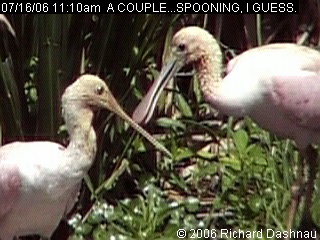
The images below are cropped from larger photos I shot,
and from frames pulled from the video clips I caught. Links to the
video clips are below them.
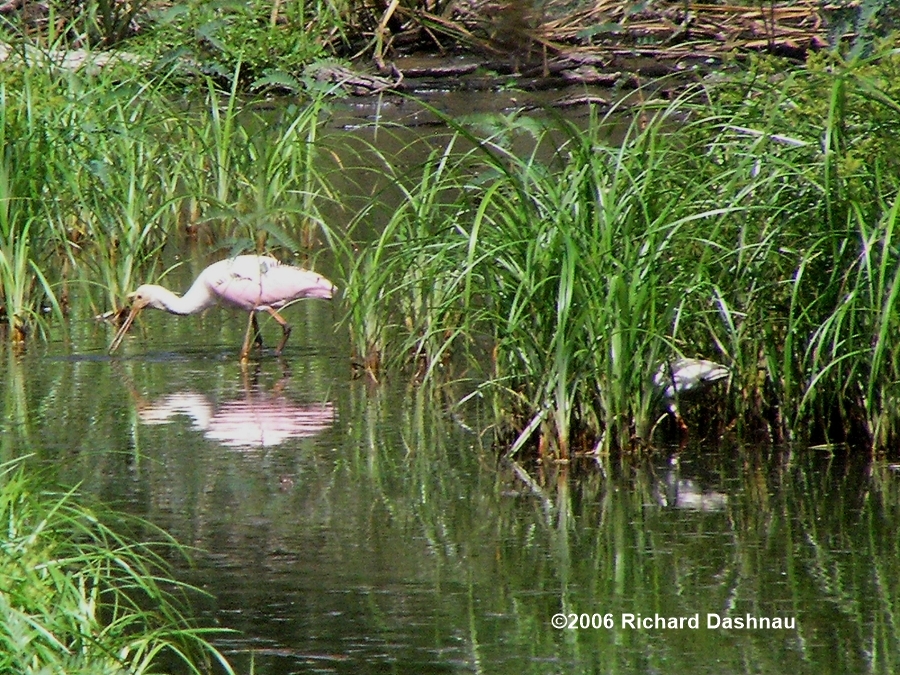 -
-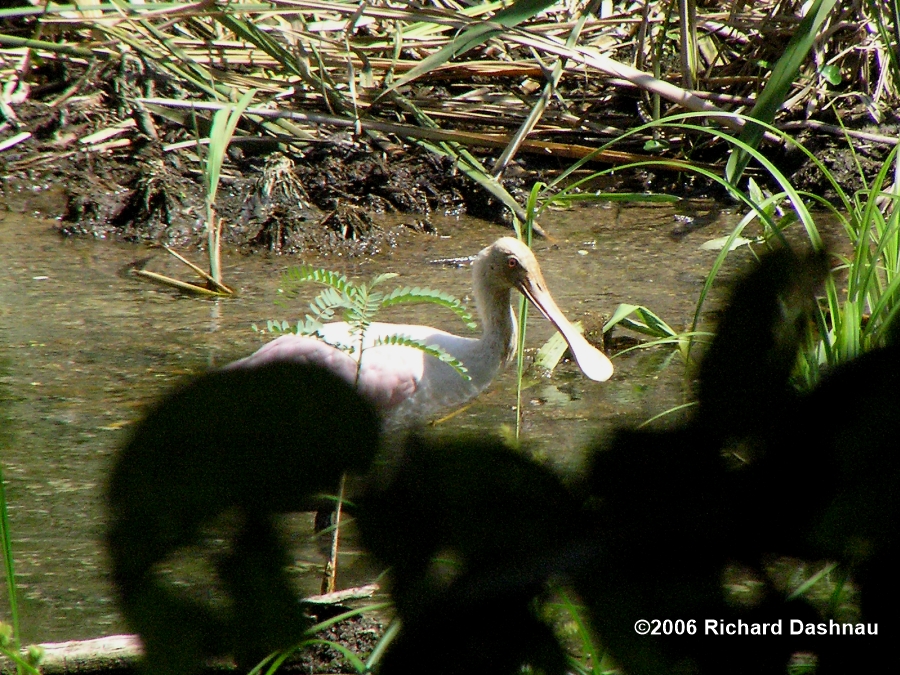 -
-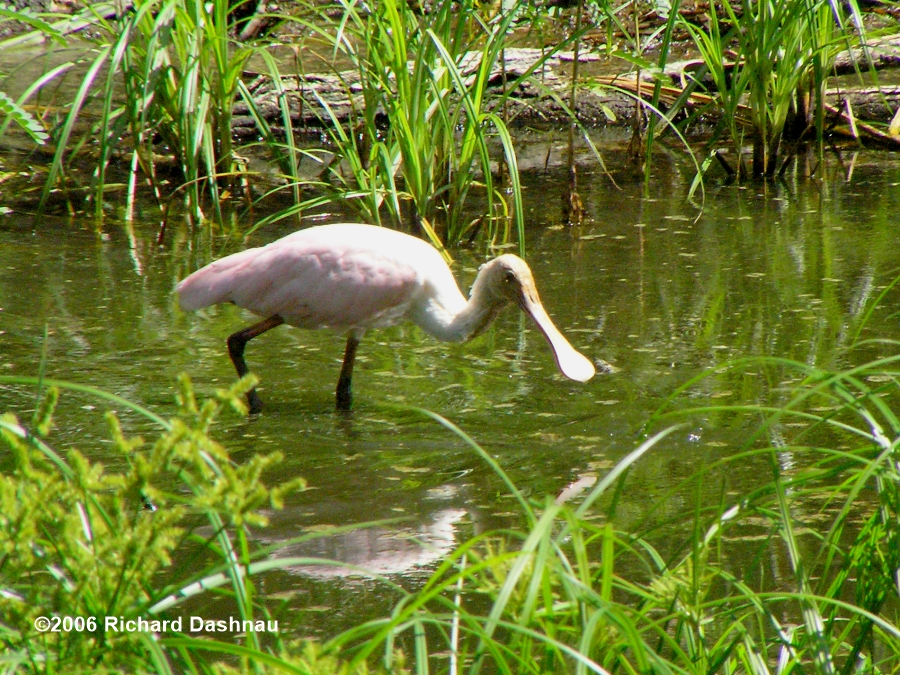
-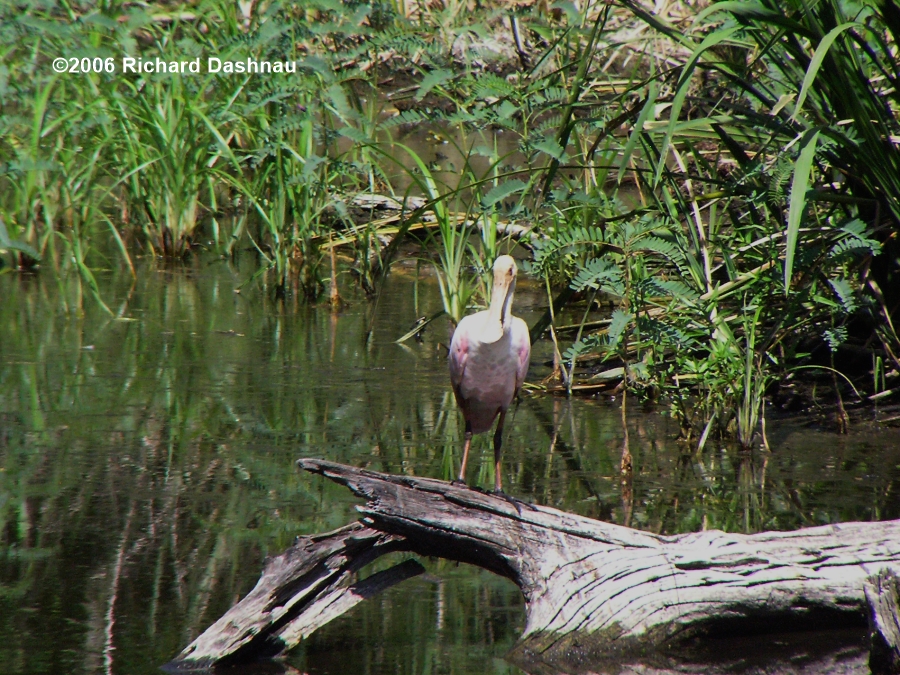 -
-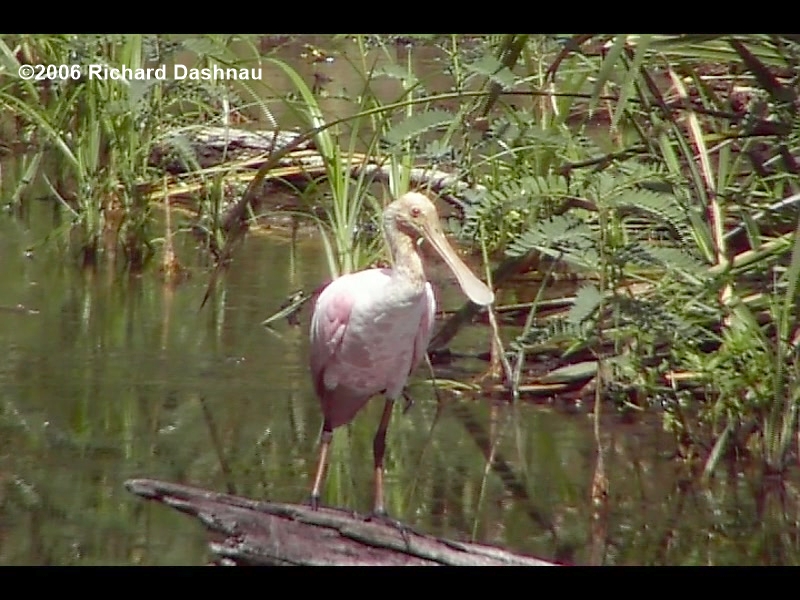 -
-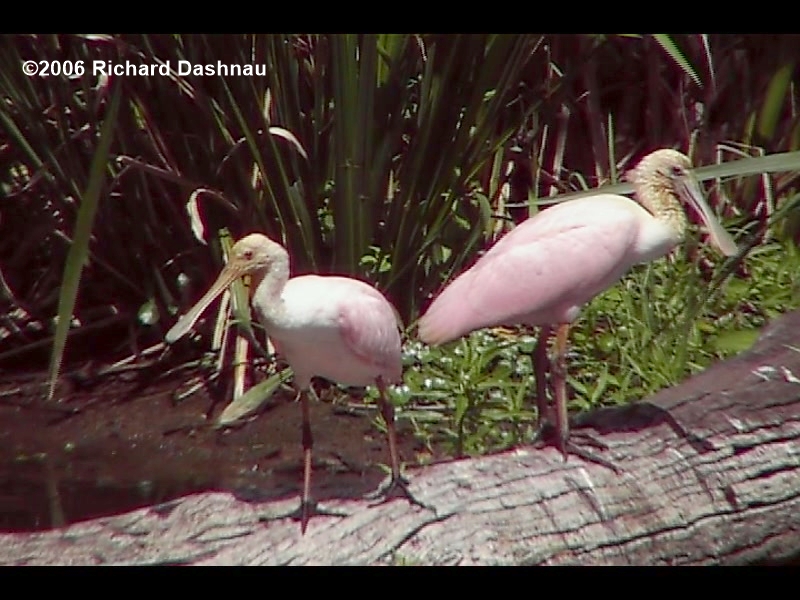
THE SPOON-SHAPED BILL
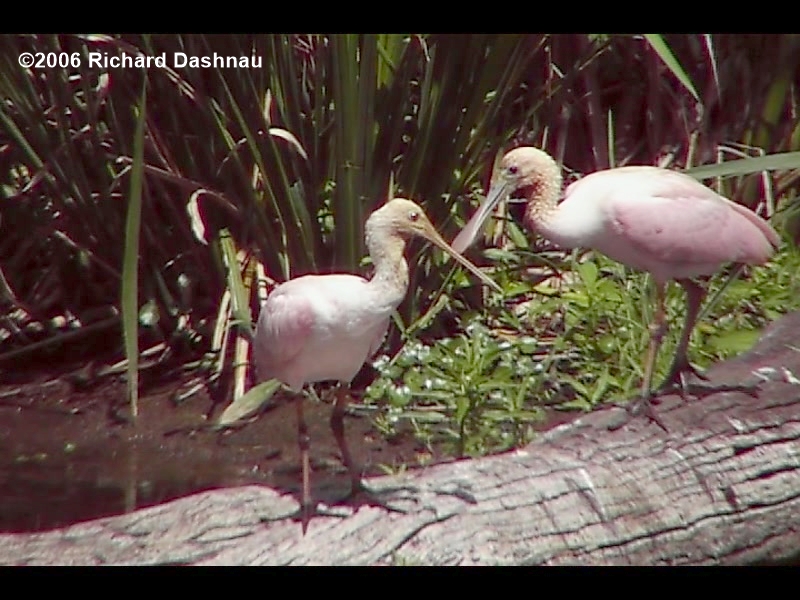 -
-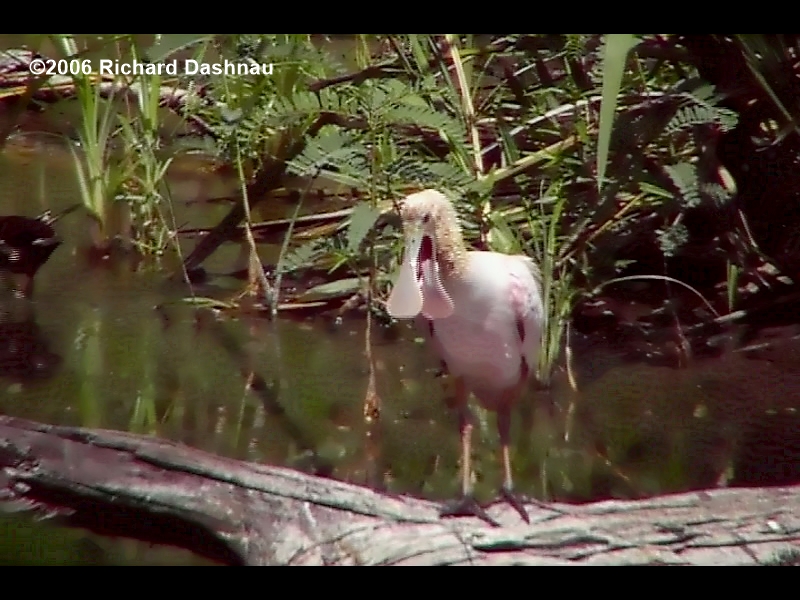 -
-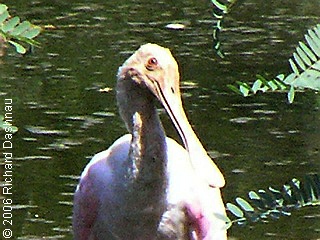
FACE TO
FACE
QUICK
YAWN
THIS IS MY BETTER SIDE
Spoonbills
Foraging
near the Spillway Trail at Elm Lake mp4
-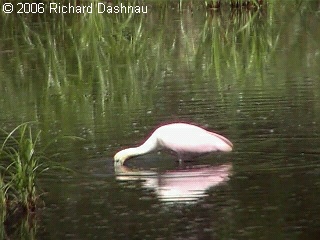 -
-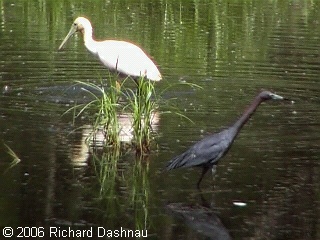
SWEEPING
A
LITTLE BLUE HERON
The clip shows the sweeping motion of the bill.
You can see that when it grabs something, the Spoonbill tosses it
up and swallows it. The clip also shows a Little Blue Heron
passing, and then more Spoonbill sweeps seen from the rear.
Keep in mind that all of these beautiful birds are free.
That is, not in a zoo. The birds are in their own habitat
and come and go as they like. And I'm lucky enough to see
them. Even with the dry conditions (and now heat over
90 degrees) Brazos Bend State Park is a joy to visit! The
clip shows a pair of the Spoonbills. There seems to be a
moment when they look eye-to-eye, and the one on the right
seems to signal with a slight opening of its bill.
While
the Spoonbills, and other birds I've mentioned in these pages, can
be sometimes be found easily if you know where to look elsewhere
in Texas or the United States--almost
ALL of the birds I've shown have been seen within a
mile and a half radius around the observation tower! And
they are ALL WILD!
Go
back to my home page, Welcome to
rickubis.com
Go back to the RICKUBISCAM
page.
Go back to the See
the World page.




























































































 -
- -
-
 -
- -
-
 -
- -
-
 -
-